Unit 12: Organizational Behavior PDF
VerifiedAdded on 2021/11/18
|20
|5972
|43
AI Summary
Contribute Materials
Your contribution can guide someone’s learning journey. Share your
documents today.
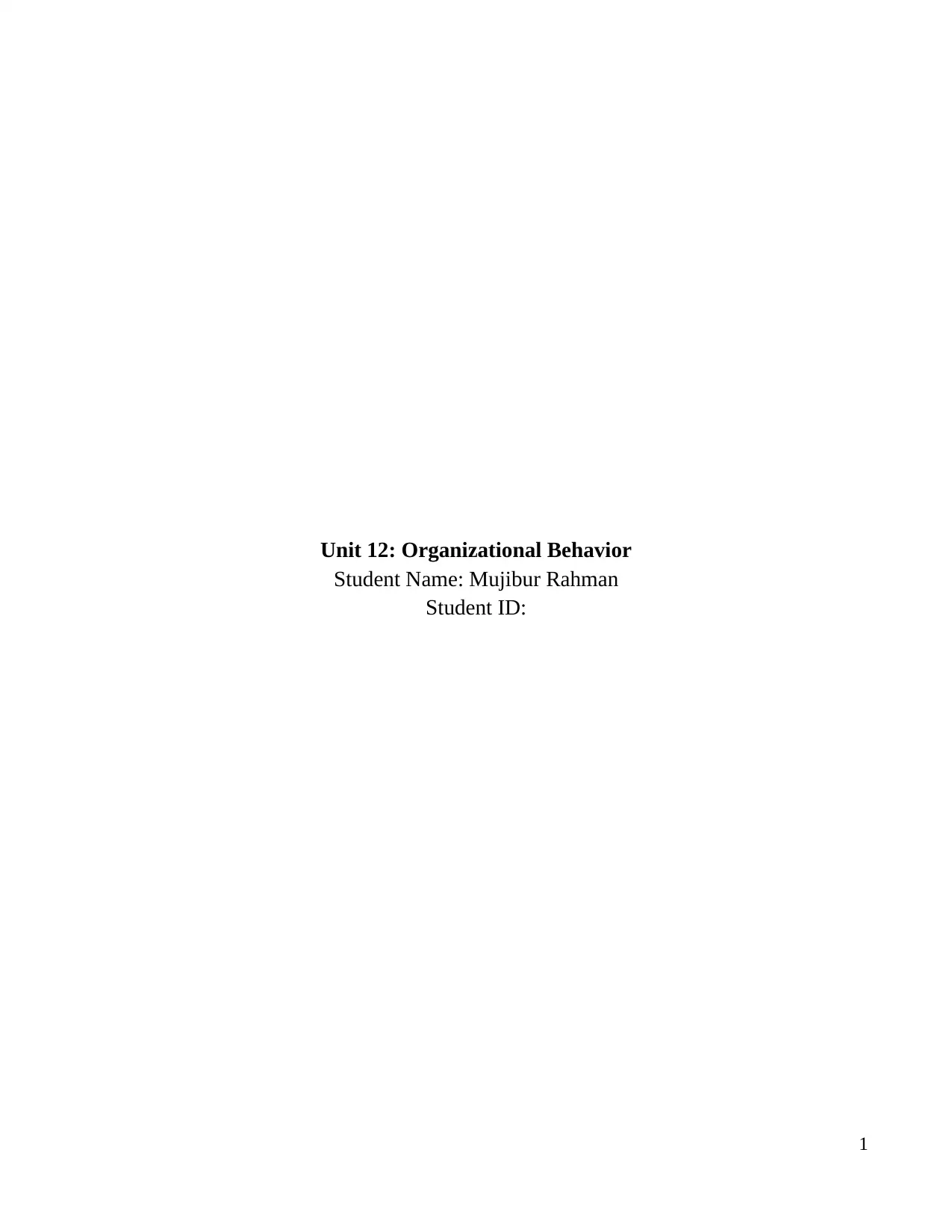
Unit 12: Organizational Behavior
Student Name: Mujibur Rahman
Student ID:
1
Student Name: Mujibur Rahman
Student ID:
1
Secure Best Marks with AI Grader
Need help grading? Try our AI Grader for instant feedback on your assignments.
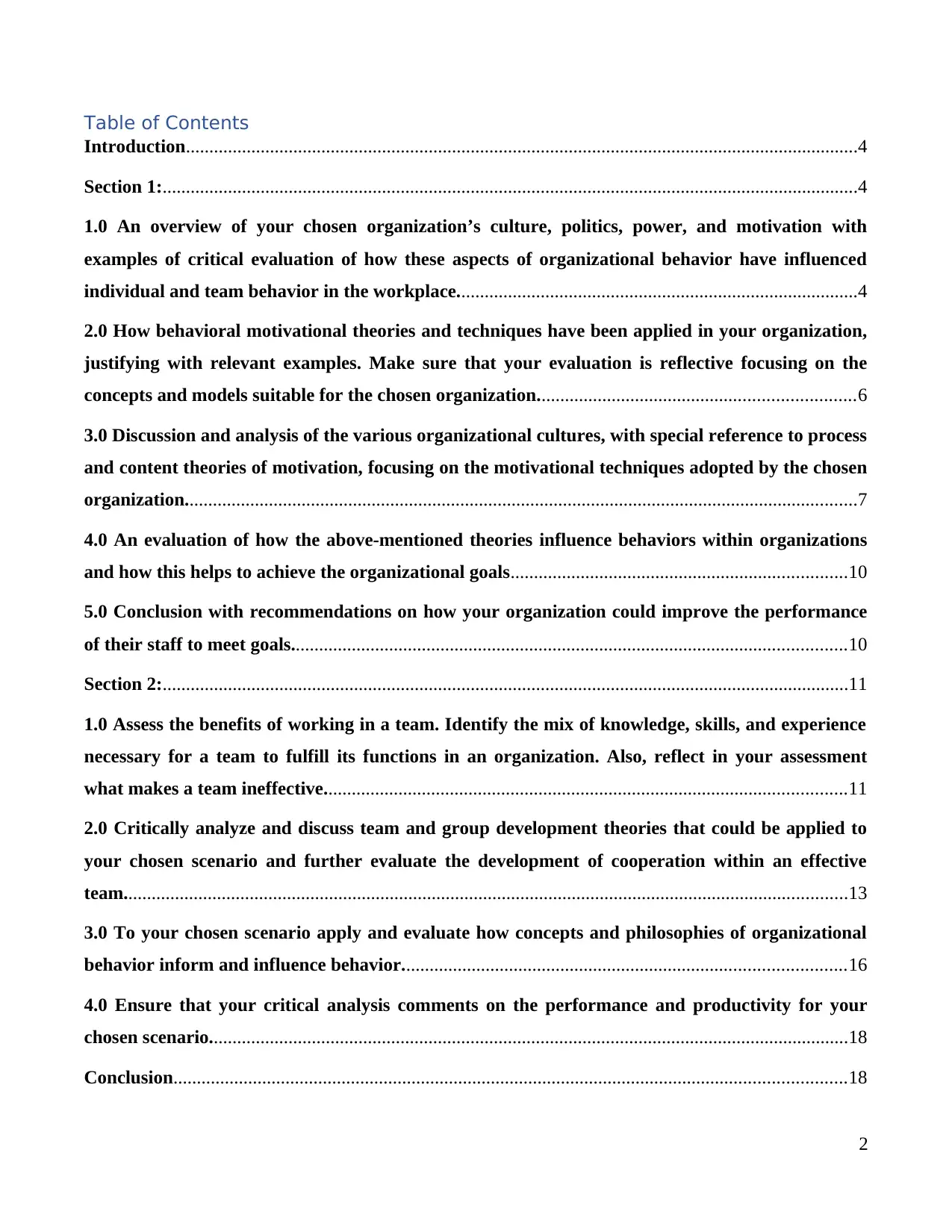
Table of Contents
Introduction................................................................................................................................................4
Section 1:.....................................................................................................................................................4
1.0 An overview of your chosen organization’s culture, politics, power, and motivation with
examples of critical evaluation of how these aspects of organizational behavior have influenced
individual and team behavior in the workplace......................................................................................4
2.0 How behavioral motivational theories and techniques have been applied in your organization,
justifying with relevant examples. Make sure that your evaluation is reflective focusing on the
concepts and models suitable for the chosen organization....................................................................6
3.0 Discussion and analysis of the various organizational cultures, with special reference to process
and content theories of motivation, focusing on the motivational techniques adopted by the chosen
organization................................................................................................................................................7
4.0 An evaluation of how the above-mentioned theories influence behaviors within organizations
and how this helps to achieve the organizational goals........................................................................10
5.0 Conclusion with recommendations on how your organization could improve the performance
of their staff to meet goals.......................................................................................................................10
Section 2:...................................................................................................................................................11
1.0 Assess the benefits of working in a team. Identify the mix of knowledge, skills, and experience
necessary for a team to fulfill its functions in an organization. Also, reflect in your assessment
what makes a team ineffective................................................................................................................11
2.0 Critically analyze and discuss team and group development theories that could be applied to
your chosen scenario and further evaluate the development of cooperation within an effective
team...........................................................................................................................................................13
3.0 To your chosen scenario apply and evaluate how concepts and philosophies of organizational
behavior inform and influence behavior...............................................................................................16
4.0 Ensure that your critical analysis comments on the performance and productivity for your
chosen scenario.........................................................................................................................................18
Conclusion................................................................................................................................................18
2
Introduction................................................................................................................................................4
Section 1:.....................................................................................................................................................4
1.0 An overview of your chosen organization’s culture, politics, power, and motivation with
examples of critical evaluation of how these aspects of organizational behavior have influenced
individual and team behavior in the workplace......................................................................................4
2.0 How behavioral motivational theories and techniques have been applied in your organization,
justifying with relevant examples. Make sure that your evaluation is reflective focusing on the
concepts and models suitable for the chosen organization....................................................................6
3.0 Discussion and analysis of the various organizational cultures, with special reference to process
and content theories of motivation, focusing on the motivational techniques adopted by the chosen
organization................................................................................................................................................7
4.0 An evaluation of how the above-mentioned theories influence behaviors within organizations
and how this helps to achieve the organizational goals........................................................................10
5.0 Conclusion with recommendations on how your organization could improve the performance
of their staff to meet goals.......................................................................................................................10
Section 2:...................................................................................................................................................11
1.0 Assess the benefits of working in a team. Identify the mix of knowledge, skills, and experience
necessary for a team to fulfill its functions in an organization. Also, reflect in your assessment
what makes a team ineffective................................................................................................................11
2.0 Critically analyze and discuss team and group development theories that could be applied to
your chosen scenario and further evaluate the development of cooperation within an effective
team...........................................................................................................................................................13
3.0 To your chosen scenario apply and evaluate how concepts and philosophies of organizational
behavior inform and influence behavior...............................................................................................16
4.0 Ensure that your critical analysis comments on the performance and productivity for your
chosen scenario.........................................................................................................................................18
Conclusion................................................................................................................................................18
2
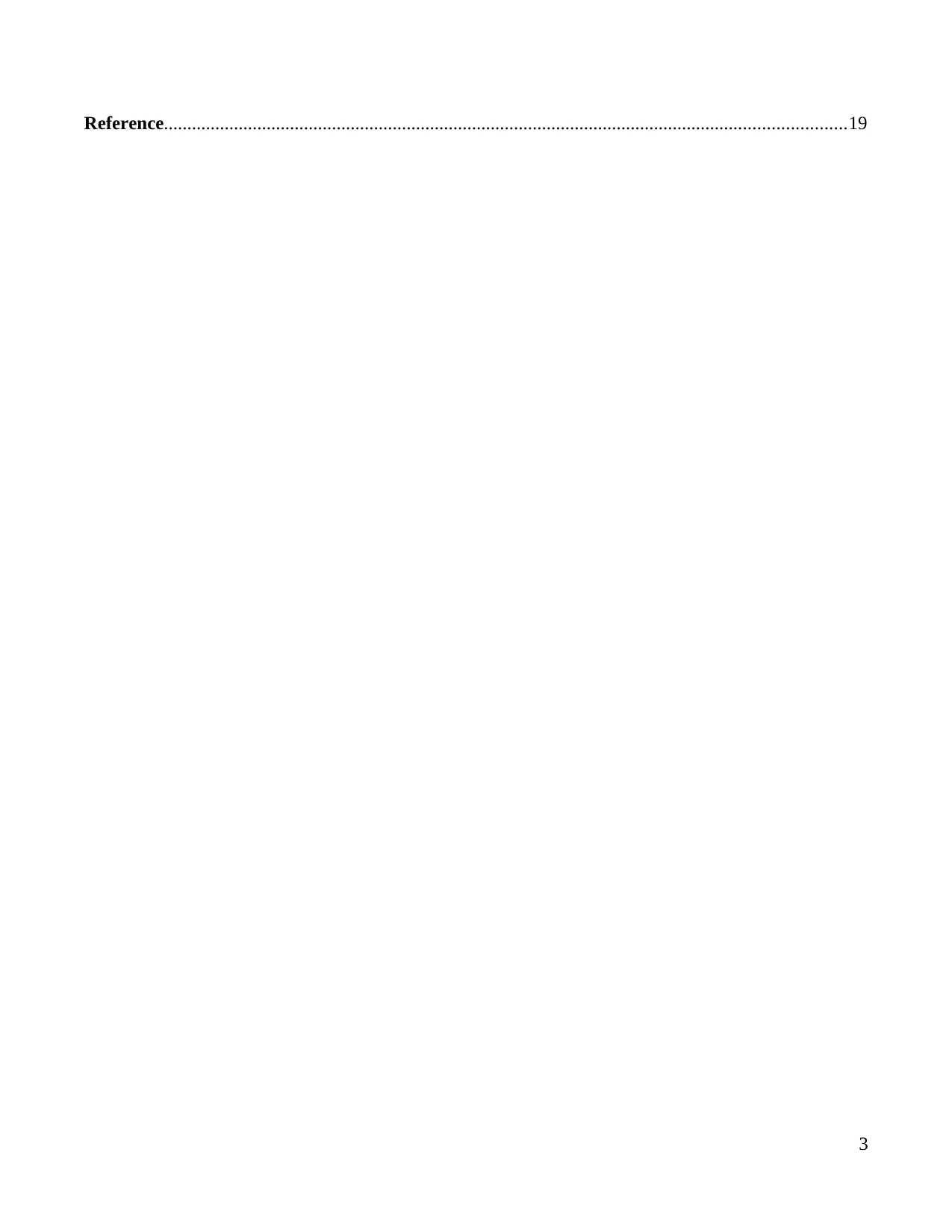
Reference..................................................................................................................................................19
3
3
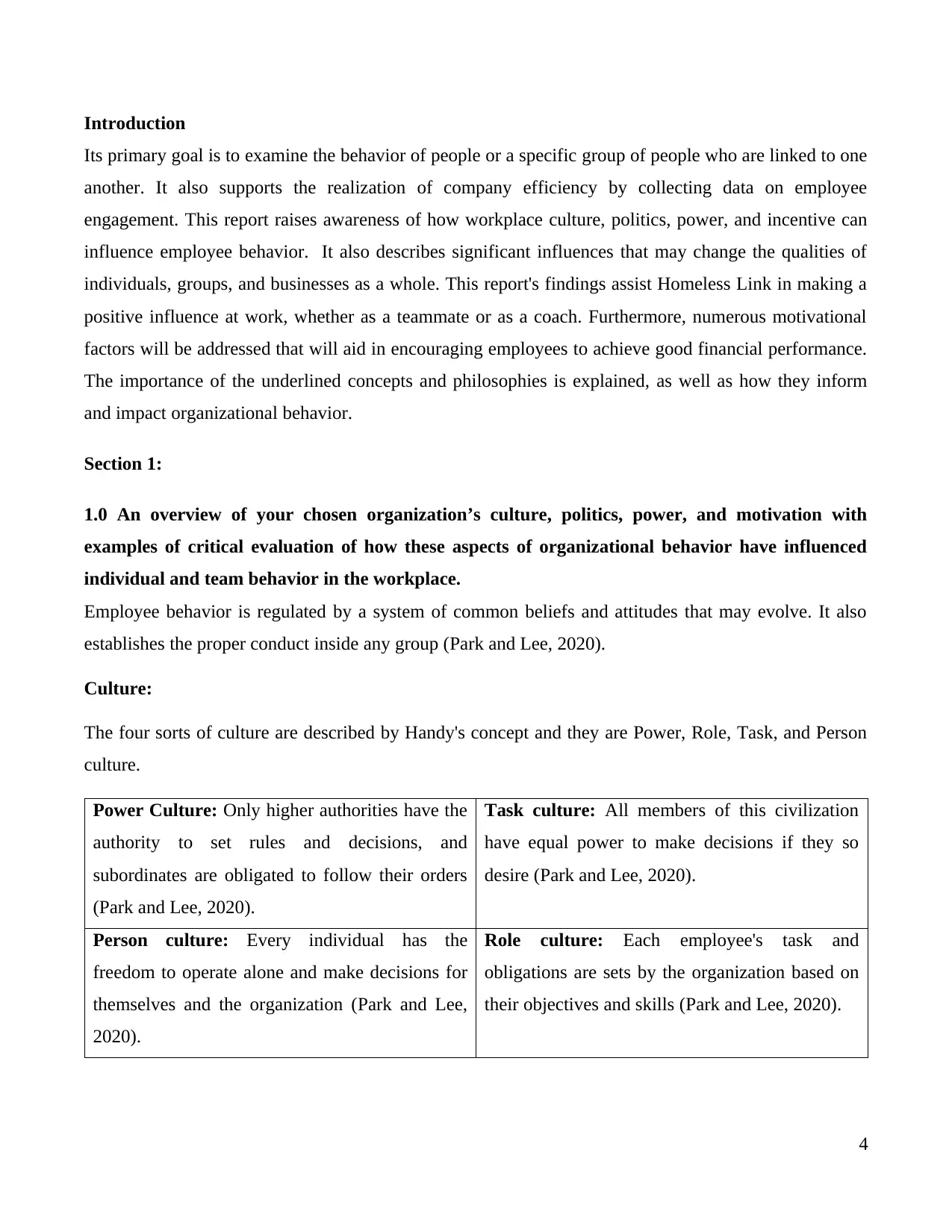
Introduction
Its primary goal is to examine the behavior of people or a specific group of people who are linked to one
another. It also supports the realization of company efficiency by collecting data on employee
engagement. This report raises awareness of how workplace culture, politics, power, and incentive can
influence employee behavior. It also describes significant influences that may change the qualities of
individuals, groups, and businesses as a whole. This report's findings assist Homeless Link in making a
positive influence at work, whether as a teammate or as a coach. Furthermore, numerous motivational
factors will be addressed that will aid in encouraging employees to achieve good financial performance.
The importance of the underlined concepts and philosophies is explained, as well as how they inform
and impact organizational behavior.
Section 1:
1.0 An overview of your chosen organization’s culture, politics, power, and motivation with
examples of critical evaluation of how these aspects of organizational behavior have influenced
individual and team behavior in the workplace.
Employee behavior is regulated by a system of common beliefs and attitudes that may evolve. It also
establishes the proper conduct inside any group (Park and Lee, 2020).
Culture:
The four sorts of culture are described by Handy's concept and they are Power, Role, Task, and Person
culture.
Power Culture: Only higher authorities have the
authority to set rules and decisions, and
subordinates are obligated to follow their orders
(Park and Lee, 2020).
Task culture: All members of this civilization
have equal power to make decisions if they so
desire (Park and Lee, 2020).
Person culture: Every individual has the
freedom to operate alone and make decisions for
themselves and the organization (Park and Lee,
2020).
Role culture: Each employee's task and
obligations are sets by the organization based on
their objectives and skills (Park and Lee, 2020).
4
Its primary goal is to examine the behavior of people or a specific group of people who are linked to one
another. It also supports the realization of company efficiency by collecting data on employee
engagement. This report raises awareness of how workplace culture, politics, power, and incentive can
influence employee behavior. It also describes significant influences that may change the qualities of
individuals, groups, and businesses as a whole. This report's findings assist Homeless Link in making a
positive influence at work, whether as a teammate or as a coach. Furthermore, numerous motivational
factors will be addressed that will aid in encouraging employees to achieve good financial performance.
The importance of the underlined concepts and philosophies is explained, as well as how they inform
and impact organizational behavior.
Section 1:
1.0 An overview of your chosen organization’s culture, politics, power, and motivation with
examples of critical evaluation of how these aspects of organizational behavior have influenced
individual and team behavior in the workplace.
Employee behavior is regulated by a system of common beliefs and attitudes that may evolve. It also
establishes the proper conduct inside any group (Park and Lee, 2020).
Culture:
The four sorts of culture are described by Handy's concept and they are Power, Role, Task, and Person
culture.
Power Culture: Only higher authorities have the
authority to set rules and decisions, and
subordinates are obligated to follow their orders
(Park and Lee, 2020).
Task culture: All members of this civilization
have equal power to make decisions if they so
desire (Park and Lee, 2020).
Person culture: Every individual has the
freedom to operate alone and make decisions for
themselves and the organization (Park and Lee,
2020).
Role culture: Each employee's task and
obligations are sets by the organization based on
their objectives and skills (Park and Lee, 2020).
4
Secure Best Marks with AI Grader
Need help grading? Try our AI Grader for instant feedback on your assignments.
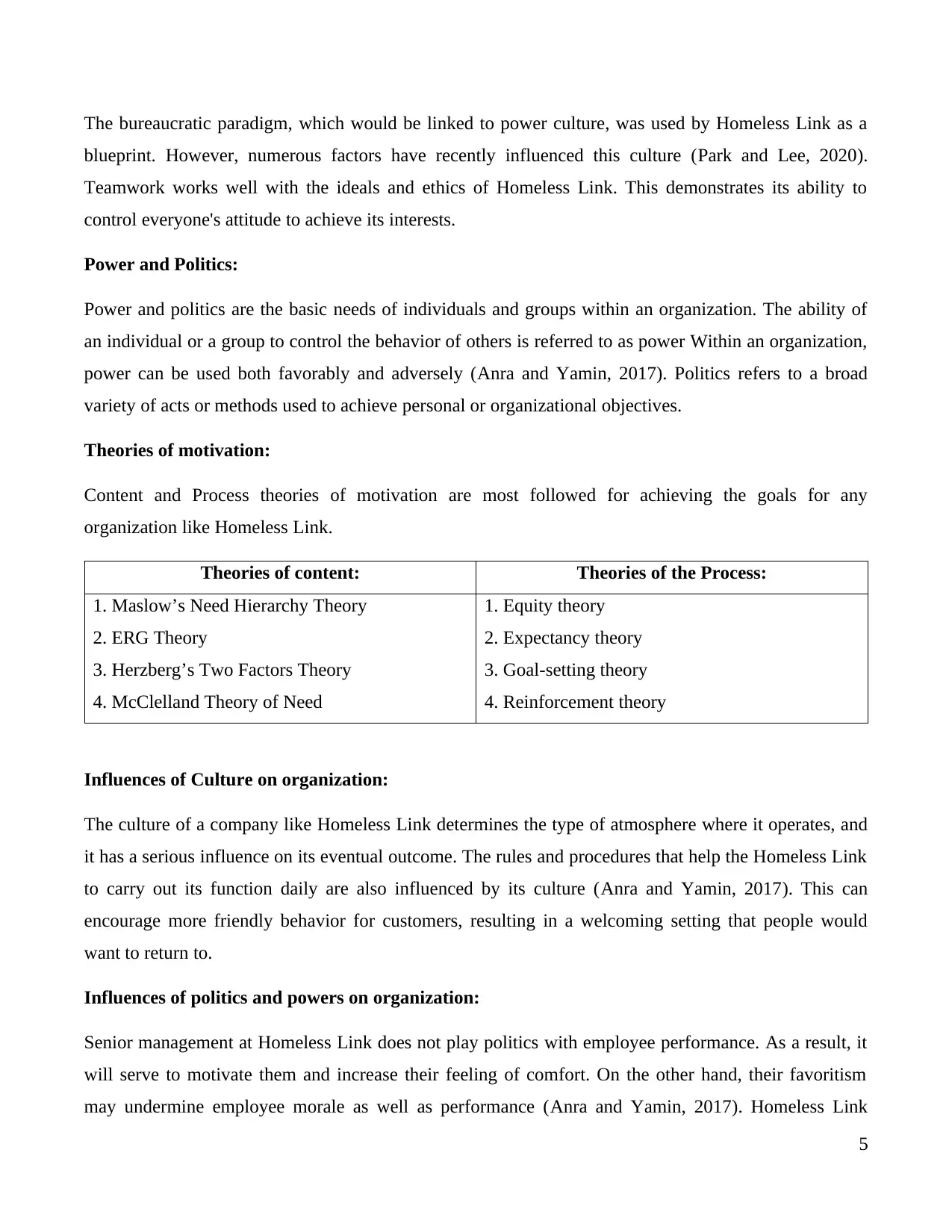
The bureaucratic paradigm, which would be linked to power culture, was used by Homeless Link as a
blueprint. However, numerous factors have recently influenced this culture (Park and Lee, 2020).
Teamwork works well with the ideals and ethics of Homeless Link. This demonstrates its ability to
control everyone's attitude to achieve its interests.
Power and Politics:
Power and politics are the basic needs of individuals and groups within an organization. The ability of
an individual or a group to control the behavior of others is referred to as power Within an organization,
power can be used both favorably and adversely (Anra and Yamin, 2017). Politics refers to a broad
variety of acts or methods used to achieve personal or organizational objectives.
Theories of motivation:
Content and Process theories of motivation are most followed for achieving the goals for any
organization like Homeless Link.
Theories of content: Theories of the Process:
1. Maslow’s Need Hierarchy Theory
2. ERG Theory
3. Herzberg’s Two Factors Theory
4. McClelland Theory of Need
1. Equity theory
2. Expectancy theory
3. Goal-setting theory
4. Reinforcement theory
Influences of Culture on organization:
The culture of a company like Homeless Link determines the type of atmosphere where it operates, and
it has a serious influence on its eventual outcome. The rules and procedures that help the Homeless Link
to carry out its function daily are also influenced by its culture (Anra and Yamin, 2017). This can
encourage more friendly behavior for customers, resulting in a welcoming setting that people would
want to return to.
Influences of politics and powers on organization:
Senior management at Homeless Link does not play politics with employee performance. As a result, it
will serve to motivate them and increase their feeling of comfort. On the other hand, their favoritism
may undermine employee morale as well as performance (Anra and Yamin, 2017). Homeless Link
5
blueprint. However, numerous factors have recently influenced this culture (Park and Lee, 2020).
Teamwork works well with the ideals and ethics of Homeless Link. This demonstrates its ability to
control everyone's attitude to achieve its interests.
Power and Politics:
Power and politics are the basic needs of individuals and groups within an organization. The ability of
an individual or a group to control the behavior of others is referred to as power Within an organization,
power can be used both favorably and adversely (Anra and Yamin, 2017). Politics refers to a broad
variety of acts or methods used to achieve personal or organizational objectives.
Theories of motivation:
Content and Process theories of motivation are most followed for achieving the goals for any
organization like Homeless Link.
Theories of content: Theories of the Process:
1. Maslow’s Need Hierarchy Theory
2. ERG Theory
3. Herzberg’s Two Factors Theory
4. McClelland Theory of Need
1. Equity theory
2. Expectancy theory
3. Goal-setting theory
4. Reinforcement theory
Influences of Culture on organization:
The culture of a company like Homeless Link determines the type of atmosphere where it operates, and
it has a serious influence on its eventual outcome. The rules and procedures that help the Homeless Link
to carry out its function daily are also influenced by its culture (Anra and Yamin, 2017). This can
encourage more friendly behavior for customers, resulting in a welcoming setting that people would
want to return to.
Influences of politics and powers on organization:
Senior management at Homeless Link does not play politics with employee performance. As a result, it
will serve to motivate them and increase their feeling of comfort. On the other hand, their favoritism
may undermine employee morale as well as performance (Anra and Yamin, 2017). Homeless Link
5
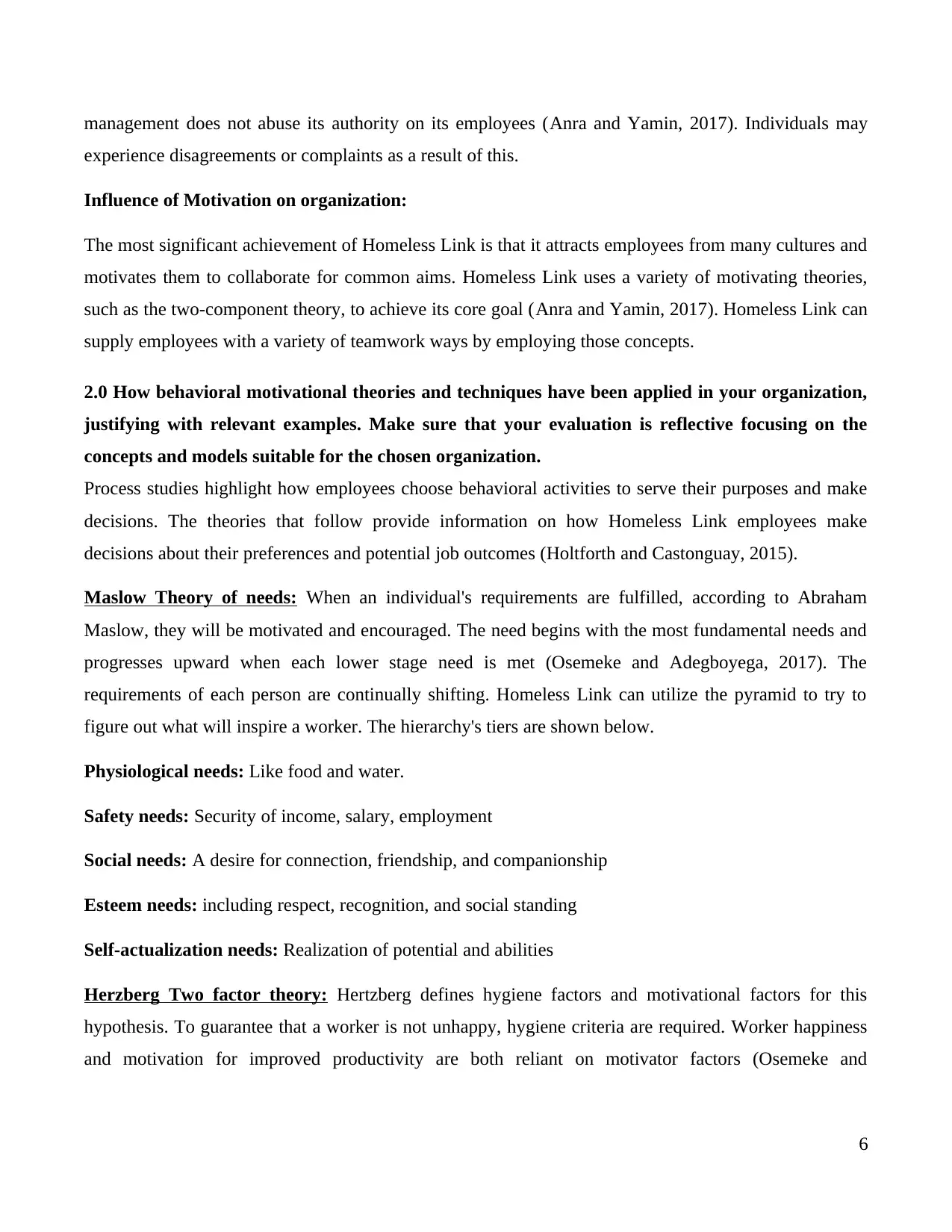
management does not abuse its authority on its employees (Anra and Yamin, 2017). Individuals may
experience disagreements or complaints as a result of this.
Influence of Motivation on organization:
The most significant achievement of Homeless Link is that it attracts employees from many cultures and
motivates them to collaborate for common aims. Homeless Link uses a variety of motivating theories,
such as the two-component theory, to achieve its core goal (Anra and Yamin, 2017). Homeless Link can
supply employees with a variety of teamwork ways by employing those concepts.
2.0 How behavioral motivational theories and techniques have been applied in your organization,
justifying with relevant examples. Make sure that your evaluation is reflective focusing on the
concepts and models suitable for the chosen organization.
Process studies highlight how employees choose behavioral activities to serve their purposes and make
decisions. The theories that follow provide information on how Homeless Link employees make
decisions about their preferences and potential job outcomes (Holtforth and Castonguay, 2015).
Maslow Theory of needs: When an individual's requirements are fulfilled, according to Abraham
Maslow, they will be motivated and encouraged. The need begins with the most fundamental needs and
progresses upward when each lower stage need is met (Osemeke and Adegboyega, 2017). The
requirements of each person are continually shifting. Homeless Link can utilize the pyramid to try to
figure out what will inspire a worker. The hierarchy's tiers are shown below.
Physiological needs: Like food and water.
Safety needs: Security of income, salary, employment
Social needs: A desire for connection, friendship, and companionship
Esteem needs: including respect, recognition, and social standing
Self-actualization needs: Realization of potential and abilities
Herzberg Two factor theory: Hertzberg defines hygiene factors and motivational factors for this
hypothesis. To guarantee that a worker is not unhappy, hygiene criteria are required. Worker happiness
and motivation for improved productivity are both reliant on motivator factors (Osemeke and
6
experience disagreements or complaints as a result of this.
Influence of Motivation on organization:
The most significant achievement of Homeless Link is that it attracts employees from many cultures and
motivates them to collaborate for common aims. Homeless Link uses a variety of motivating theories,
such as the two-component theory, to achieve its core goal (Anra and Yamin, 2017). Homeless Link can
supply employees with a variety of teamwork ways by employing those concepts.
2.0 How behavioral motivational theories and techniques have been applied in your organization,
justifying with relevant examples. Make sure that your evaluation is reflective focusing on the
concepts and models suitable for the chosen organization.
Process studies highlight how employees choose behavioral activities to serve their purposes and make
decisions. The theories that follow provide information on how Homeless Link employees make
decisions about their preferences and potential job outcomes (Holtforth and Castonguay, 2015).
Maslow Theory of needs: When an individual's requirements are fulfilled, according to Abraham
Maslow, they will be motivated and encouraged. The need begins with the most fundamental needs and
progresses upward when each lower stage need is met (Osemeke and Adegboyega, 2017). The
requirements of each person are continually shifting. Homeless Link can utilize the pyramid to try to
figure out what will inspire a worker. The hierarchy's tiers are shown below.
Physiological needs: Like food and water.
Safety needs: Security of income, salary, employment
Social needs: A desire for connection, friendship, and companionship
Esteem needs: including respect, recognition, and social standing
Self-actualization needs: Realization of potential and abilities
Herzberg Two factor theory: Hertzberg defines hygiene factors and motivational factors for this
hypothesis. To guarantee that a worker is not unhappy, hygiene criteria are required. Worker happiness
and motivation for improved productivity are both reliant on motivator factors (Osemeke and
6
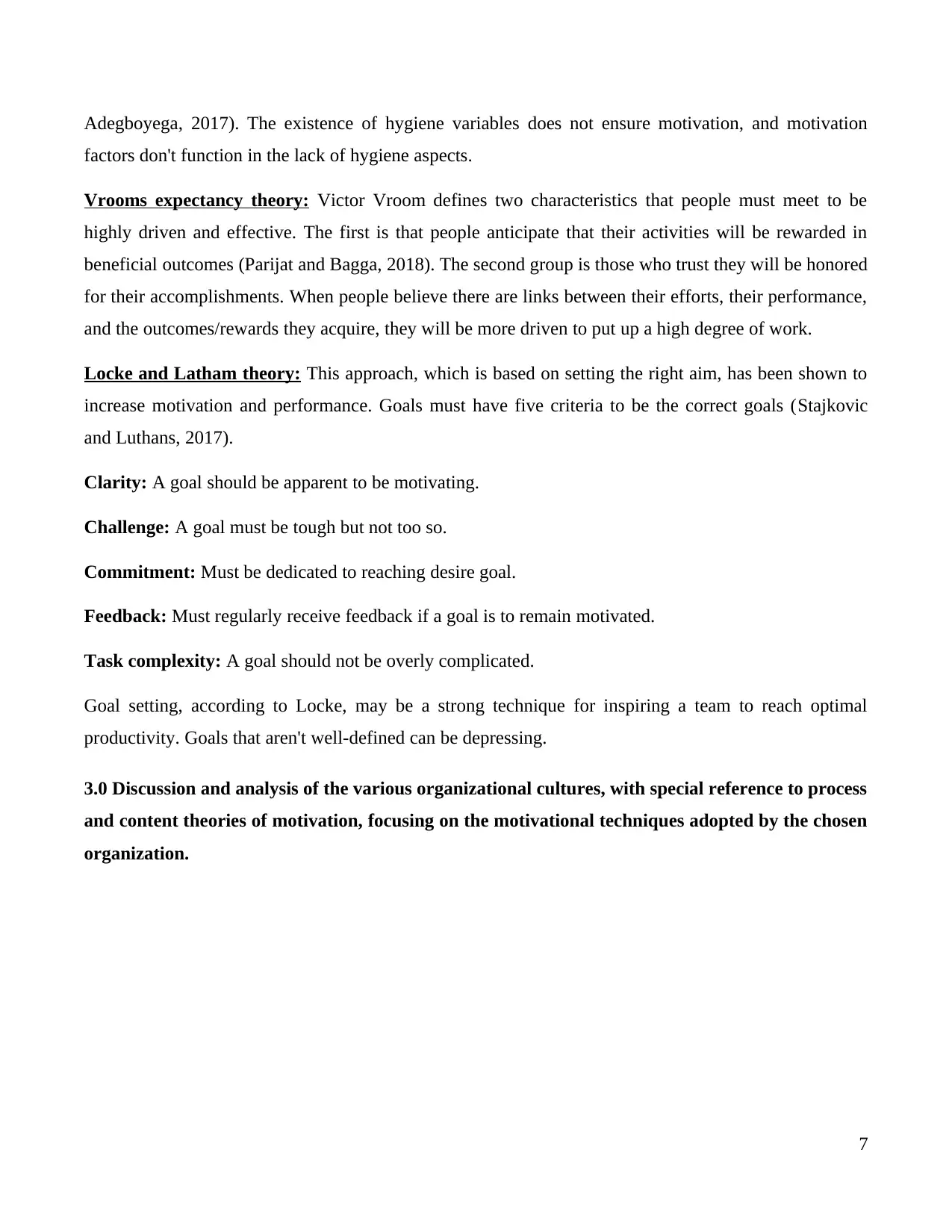
Adegboyega, 2017). The existence of hygiene variables does not ensure motivation, and motivation
factors don't function in the lack of hygiene aspects.
Vrooms expectancy theory: Victor Vroom defines two characteristics that people must meet to be
highly driven and effective. The first is that people anticipate that their activities will be rewarded in
beneficial outcomes (Parijat and Bagga, 2018). The second group is those who trust they will be honored
for their accomplishments. When people believe there are links between their efforts, their performance,
and the outcomes/rewards they acquire, they will be more driven to put up a high degree of work.
Locke and Latham theory: This approach, which is based on setting the right aim, has been shown to
increase motivation and performance. Goals must have five criteria to be the correct goals (Stajkovic
and Luthans, 2017).
Clarity: A goal should be apparent to be motivating.
Challenge: A goal must be tough but not too so.
Commitment: Must be dedicated to reaching desire goal.
Feedback: Must regularly receive feedback if a goal is to remain motivated.
Task complexity: A goal should not be overly complicated.
Goal setting, according to Locke, may be a strong technique for inspiring a team to reach optimal
productivity. Goals that aren't well-defined can be depressing.
3.0 Discussion and analysis of the various organizational cultures, with special reference to process
and content theories of motivation, focusing on the motivational techniques adopted by the chosen
organization.
7
factors don't function in the lack of hygiene aspects.
Vrooms expectancy theory: Victor Vroom defines two characteristics that people must meet to be
highly driven and effective. The first is that people anticipate that their activities will be rewarded in
beneficial outcomes (Parijat and Bagga, 2018). The second group is those who trust they will be honored
for their accomplishments. When people believe there are links between their efforts, their performance,
and the outcomes/rewards they acquire, they will be more driven to put up a high degree of work.
Locke and Latham theory: This approach, which is based on setting the right aim, has been shown to
increase motivation and performance. Goals must have five criteria to be the correct goals (Stajkovic
and Luthans, 2017).
Clarity: A goal should be apparent to be motivating.
Challenge: A goal must be tough but not too so.
Commitment: Must be dedicated to reaching desire goal.
Feedback: Must regularly receive feedback if a goal is to remain motivated.
Task complexity: A goal should not be overly complicated.
Goal setting, according to Locke, may be a strong technique for inspiring a team to reach optimal
productivity. Goals that aren't well-defined can be depressing.
3.0 Discussion and analysis of the various organizational cultures, with special reference to process
and content theories of motivation, focusing on the motivational techniques adopted by the chosen
organization.
7
Paraphrase This Document
Need a fresh take? Get an instant paraphrase of this document with our AI Paraphraser
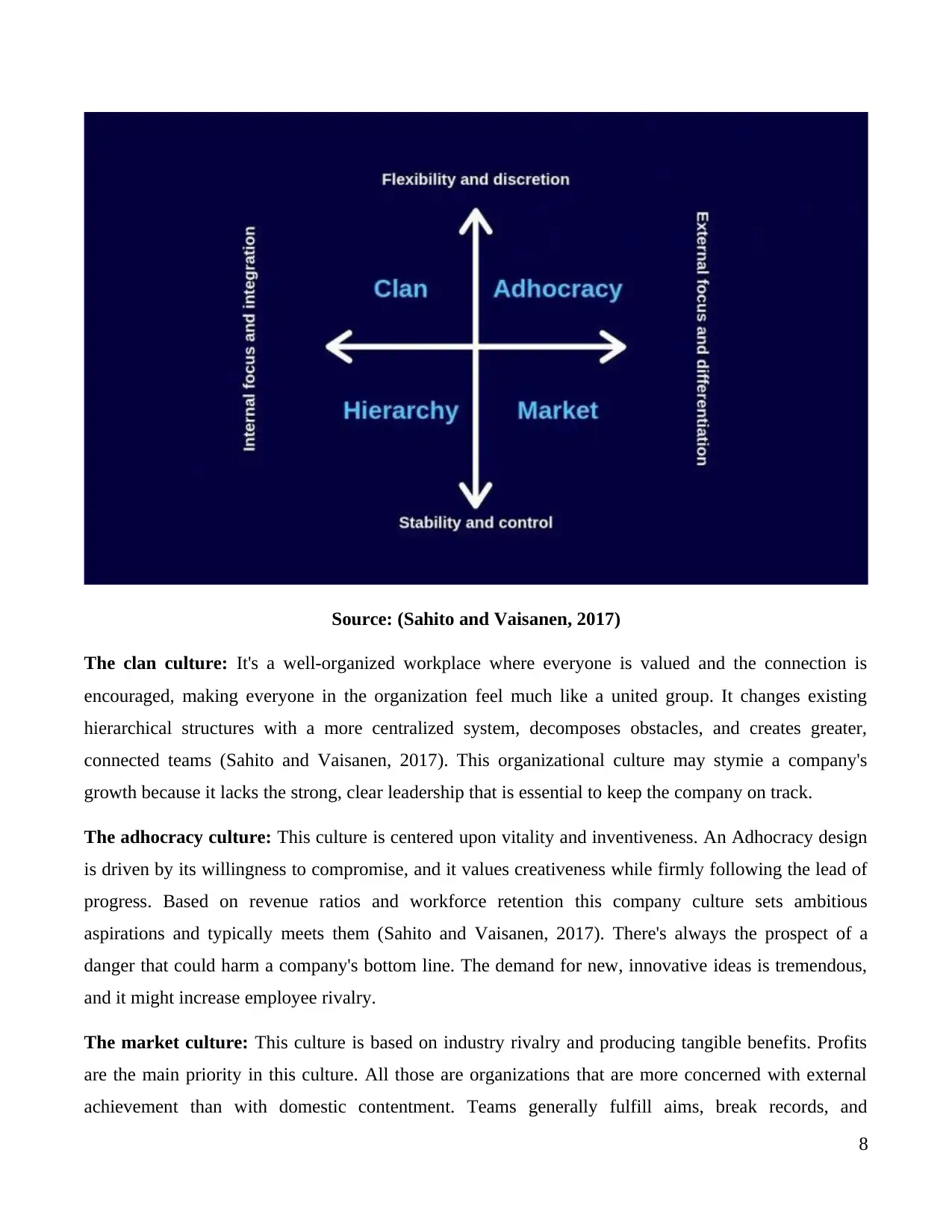
Source: (Sahito and Vaisanen, 2017)
The clan culture: It's a well-organized workplace where everyone is valued and the connection is
encouraged, making everyone in the organization feel much like a united group. It changes existing
hierarchical structures with a more centralized system, decomposes obstacles, and creates greater,
connected teams (Sahito and Vaisanen, 2017). This organizational culture may stymie a company's
growth because it lacks the strong, clear leadership that is essential to keep the company on track.
The adhocracy culture: This culture is centered upon vitality and inventiveness. An Adhocracy design
is driven by its willingness to compromise, and it values creativeness while firmly following the lead of
progress. Based on revenue ratios and workforce retention this company culture sets ambitious
aspirations and typically meets them (Sahito and Vaisanen, 2017). There's always the prospect of a
danger that could harm a company's bottom line. The demand for new, innovative ideas is tremendous,
and it might increase employee rivalry.
The market culture: This culture is based on industry rivalry and producing tangible benefits. Profits
are the main priority in this culture. All those are organizations that are more concerned with external
achievement than with domestic contentment. Teams generally fulfill aims, break records, and
8
The clan culture: It's a well-organized workplace where everyone is valued and the connection is
encouraged, making everyone in the organization feel much like a united group. It changes existing
hierarchical structures with a more centralized system, decomposes obstacles, and creates greater,
connected teams (Sahito and Vaisanen, 2017). This organizational culture may stymie a company's
growth because it lacks the strong, clear leadership that is essential to keep the company on track.
The adhocracy culture: This culture is centered upon vitality and inventiveness. An Adhocracy design
is driven by its willingness to compromise, and it values creativeness while firmly following the lead of
progress. Based on revenue ratios and workforce retention this company culture sets ambitious
aspirations and typically meets them (Sahito and Vaisanen, 2017). There's always the prospect of a
danger that could harm a company's bottom line. The demand for new, innovative ideas is tremendous,
and it might increase employee rivalry.
The market culture: This culture is based on industry rivalry and producing tangible benefits. Profits
are the main priority in this culture. All those are organizations that are more concerned with external
achievement than with domestic contentment. Teams generally fulfill aims, break records, and
8
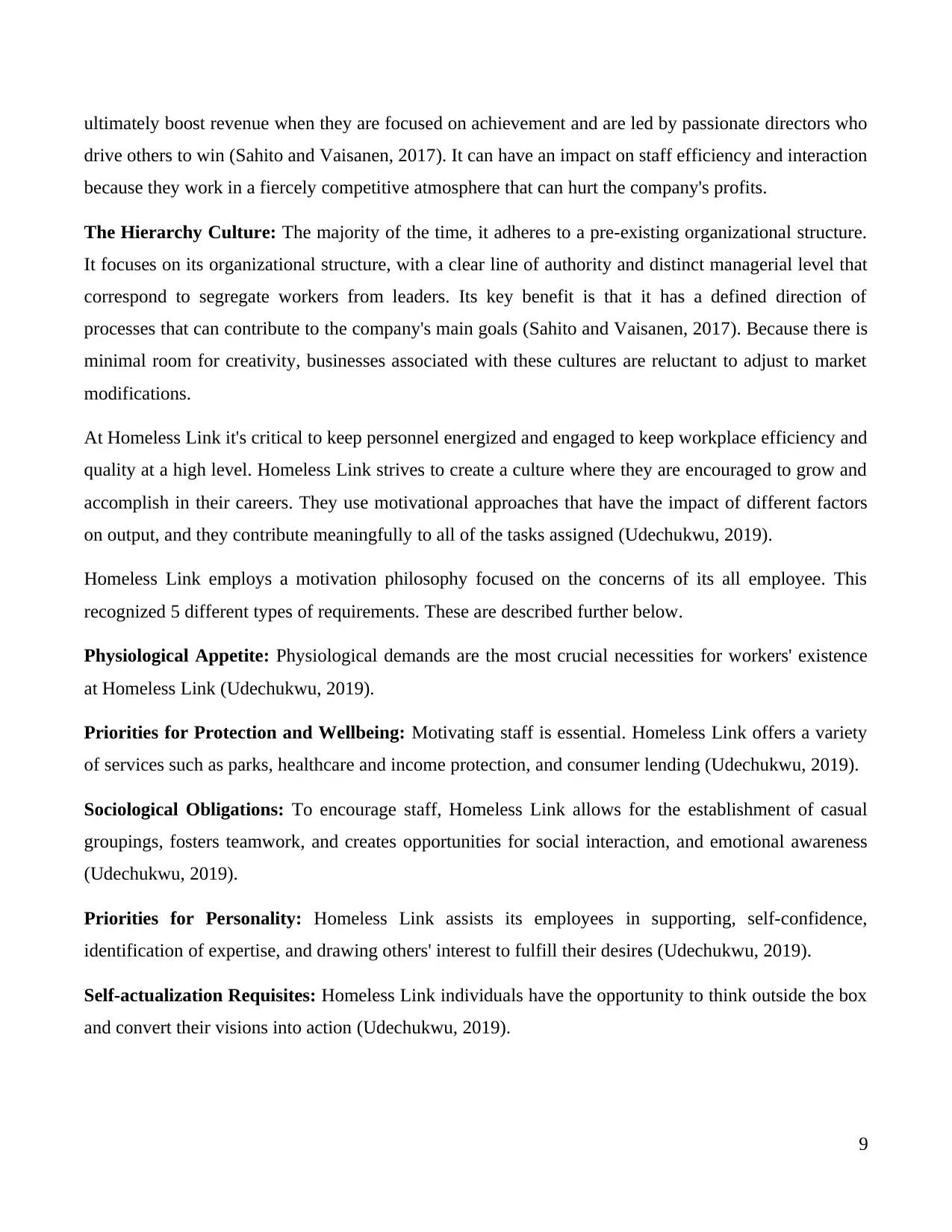
ultimately boost revenue when they are focused on achievement and are led by passionate directors who
drive others to win (Sahito and Vaisanen, 2017). It can have an impact on staff efficiency and interaction
because they work in a fiercely competitive atmosphere that can hurt the company's profits.
The Hierarchy Culture: The majority of the time, it adheres to a pre-existing organizational structure.
It focuses on its organizational structure, with a clear line of authority and distinct managerial level that
correspond to segregate workers from leaders. Its key benefit is that it has a defined direction of
processes that can contribute to the company's main goals (Sahito and Vaisanen, 2017). Because there is
minimal room for creativity, businesses associated with these cultures are reluctant to adjust to market
modifications.
At Homeless Link it's critical to keep personnel energized and engaged to keep workplace efficiency and
quality at a high level. Homeless Link strives to create a culture where they are encouraged to grow and
accomplish in their careers. They use motivational approaches that have the impact of different factors
on output, and they contribute meaningfully to all of the tasks assigned (Udechukwu, 2019).
Homeless Link employs a motivation philosophy focused on the concerns of its all employee. This
recognized 5 different types of requirements. These are described further below.
Physiological Appetite: Physiological demands are the most crucial necessities for workers' existence
at Homeless Link (Udechukwu, 2019).
Priorities for Protection and Wellbeing: Motivating staff is essential. Homeless Link offers a variety
of services such as parks, healthcare and income protection, and consumer lending (Udechukwu, 2019).
Sociological Obligations: To encourage staff, Homeless Link allows for the establishment of casual
groupings, fosters teamwork, and creates opportunities for social interaction, and emotional awareness
(Udechukwu, 2019).
Priorities for Personality: Homeless Link assists its employees in supporting, self-confidence,
identification of expertise, and drawing others' interest to fulfill their desires (Udechukwu, 2019).
Self-actualization Requisites: Homeless Link individuals have the opportunity to think outside the box
and convert their visions into action (Udechukwu, 2019).
9
drive others to win (Sahito and Vaisanen, 2017). It can have an impact on staff efficiency and interaction
because they work in a fiercely competitive atmosphere that can hurt the company's profits.
The Hierarchy Culture: The majority of the time, it adheres to a pre-existing organizational structure.
It focuses on its organizational structure, with a clear line of authority and distinct managerial level that
correspond to segregate workers from leaders. Its key benefit is that it has a defined direction of
processes that can contribute to the company's main goals (Sahito and Vaisanen, 2017). Because there is
minimal room for creativity, businesses associated with these cultures are reluctant to adjust to market
modifications.
At Homeless Link it's critical to keep personnel energized and engaged to keep workplace efficiency and
quality at a high level. Homeless Link strives to create a culture where they are encouraged to grow and
accomplish in their careers. They use motivational approaches that have the impact of different factors
on output, and they contribute meaningfully to all of the tasks assigned (Udechukwu, 2019).
Homeless Link employs a motivation philosophy focused on the concerns of its all employee. This
recognized 5 different types of requirements. These are described further below.
Physiological Appetite: Physiological demands are the most crucial necessities for workers' existence
at Homeless Link (Udechukwu, 2019).
Priorities for Protection and Wellbeing: Motivating staff is essential. Homeless Link offers a variety
of services such as parks, healthcare and income protection, and consumer lending (Udechukwu, 2019).
Sociological Obligations: To encourage staff, Homeless Link allows for the establishment of casual
groupings, fosters teamwork, and creates opportunities for social interaction, and emotional awareness
(Udechukwu, 2019).
Priorities for Personality: Homeless Link assists its employees in supporting, self-confidence,
identification of expertise, and drawing others' interest to fulfill their desires (Udechukwu, 2019).
Self-actualization Requisites: Homeless Link individuals have the opportunity to think outside the box
and convert their visions into action (Udechukwu, 2019).
9
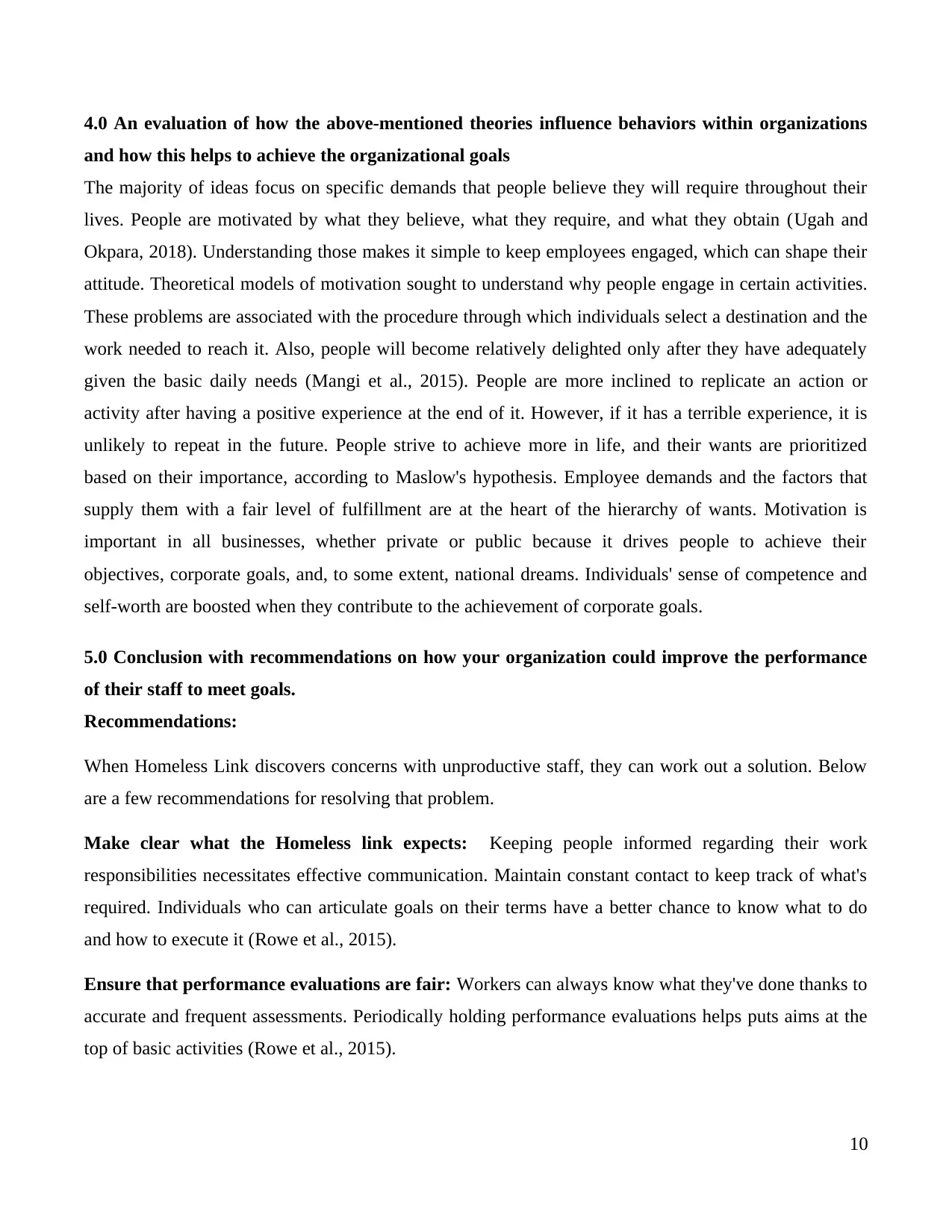
4.0 An evaluation of how the above-mentioned theories influence behaviors within organizations
and how this helps to achieve the organizational goals
The majority of ideas focus on specific demands that people believe they will require throughout their
lives. People are motivated by what they believe, what they require, and what they obtain (Ugah and
Okpara, 2018). Understanding those makes it simple to keep employees engaged, which can shape their
attitude. Theoretical models of motivation sought to understand why people engage in certain activities.
These problems are associated with the procedure through which individuals select a destination and the
work needed to reach it. Also, people will become relatively delighted only after they have adequately
given the basic daily needs (Mangi et al., 2015). People are more inclined to replicate an action or
activity after having a positive experience at the end of it. However, if it has a terrible experience, it is
unlikely to repeat in the future. People strive to achieve more in life, and their wants are prioritized
based on their importance, according to Maslow's hypothesis. Employee demands and the factors that
supply them with a fair level of fulfillment are at the heart of the hierarchy of wants. Motivation is
important in all businesses, whether private or public because it drives people to achieve their
objectives, corporate goals, and, to some extent, national dreams. Individuals' sense of competence and
self-worth are boosted when they contribute to the achievement of corporate goals.
5.0 Conclusion with recommendations on how your organization could improve the performance
of their staff to meet goals.
Recommendations:
When Homeless Link discovers concerns with unproductive staff, they can work out a solution. Below
are a few recommendations for resolving that problem.
Make clear what the Homeless link expects: Keeping people informed regarding their work
responsibilities necessitates effective communication. Maintain constant contact to keep track of what's
required. Individuals who can articulate goals on their terms have a better chance to know what to do
and how to execute it (Rowe et al., 2015).
Ensure that performance evaluations are fair: Workers can always know what they've done thanks to
accurate and frequent assessments. Periodically holding performance evaluations helps puts aims at the
top of basic activities (Rowe et al., 2015).
10
and how this helps to achieve the organizational goals
The majority of ideas focus on specific demands that people believe they will require throughout their
lives. People are motivated by what they believe, what they require, and what they obtain (Ugah and
Okpara, 2018). Understanding those makes it simple to keep employees engaged, which can shape their
attitude. Theoretical models of motivation sought to understand why people engage in certain activities.
These problems are associated with the procedure through which individuals select a destination and the
work needed to reach it. Also, people will become relatively delighted only after they have adequately
given the basic daily needs (Mangi et al., 2015). People are more inclined to replicate an action or
activity after having a positive experience at the end of it. However, if it has a terrible experience, it is
unlikely to repeat in the future. People strive to achieve more in life, and their wants are prioritized
based on their importance, according to Maslow's hypothesis. Employee demands and the factors that
supply them with a fair level of fulfillment are at the heart of the hierarchy of wants. Motivation is
important in all businesses, whether private or public because it drives people to achieve their
objectives, corporate goals, and, to some extent, national dreams. Individuals' sense of competence and
self-worth are boosted when they contribute to the achievement of corporate goals.
5.0 Conclusion with recommendations on how your organization could improve the performance
of their staff to meet goals.
Recommendations:
When Homeless Link discovers concerns with unproductive staff, they can work out a solution. Below
are a few recommendations for resolving that problem.
Make clear what the Homeless link expects: Keeping people informed regarding their work
responsibilities necessitates effective communication. Maintain constant contact to keep track of what's
required. Individuals who can articulate goals on their terms have a better chance to know what to do
and how to execute it (Rowe et al., 2015).
Ensure that performance evaluations are fair: Workers can always know what they've done thanks to
accurate and frequent assessments. Periodically holding performance evaluations helps puts aims at the
top of basic activities (Rowe et al., 2015).
10
Secure Best Marks with AI Grader
Need help grading? Try our AI Grader for instant feedback on your assignments.
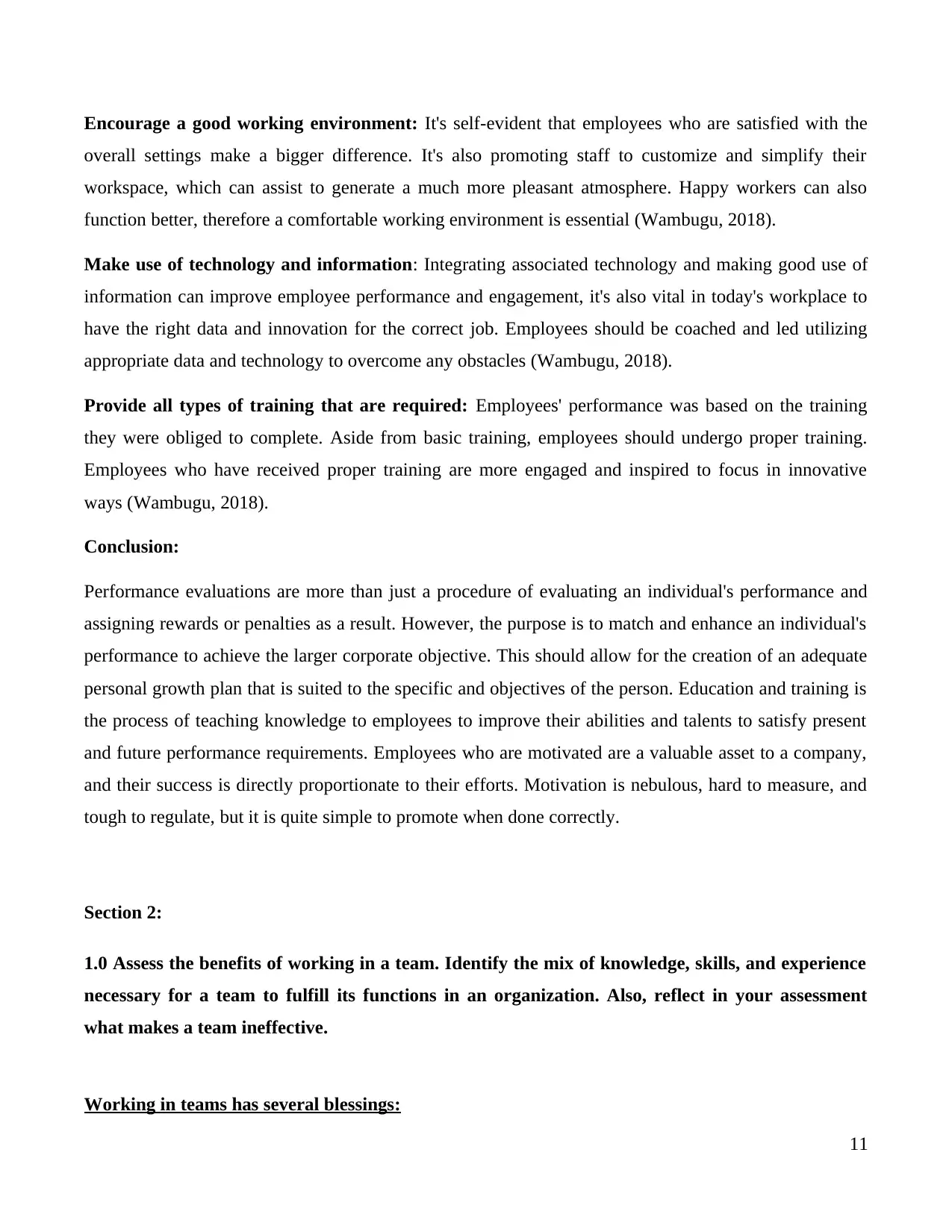
Encourage a good working environment: It's self-evident that employees who are satisfied with the
overall settings make a bigger difference. It's also promoting staff to customize and simplify their
workspace, which can assist to generate a much more pleasant atmosphere. Happy workers can also
function better, therefore a comfortable working environment is essential (Wambugu, 2018).
Make use of technology and information: Integrating associated technology and making good use of
information can improve employee performance and engagement, it's also vital in today's workplace to
have the right data and innovation for the correct job. Employees should be coached and led utilizing
appropriate data and technology to overcome any obstacles (Wambugu, 2018).
Provide all types of training that are required: Employees' performance was based on the training
they were obliged to complete. Aside from basic training, employees should undergo proper training.
Employees who have received proper training are more engaged and inspired to focus in innovative
ways (Wambugu, 2018).
Conclusion:
Performance evaluations are more than just a procedure of evaluating an individual's performance and
assigning rewards or penalties as a result. However, the purpose is to match and enhance an individual's
performance to achieve the larger corporate objective. This should allow for the creation of an adequate
personal growth plan that is suited to the specific and objectives of the person. Education and training is
the process of teaching knowledge to employees to improve their abilities and talents to satisfy present
and future performance requirements. Employees who are motivated are a valuable asset to a company,
and their success is directly proportionate to their efforts. Motivation is nebulous, hard to measure, and
tough to regulate, but it is quite simple to promote when done correctly.
Section 2:
1.0 Assess the benefits of working in a team. Identify the mix of knowledge, skills, and experience
necessary for a team to fulfill its functions in an organization. Also, reflect in your assessment
what makes a team ineffective.
Working in teams has several blessings:
11
overall settings make a bigger difference. It's also promoting staff to customize and simplify their
workspace, which can assist to generate a much more pleasant atmosphere. Happy workers can also
function better, therefore a comfortable working environment is essential (Wambugu, 2018).
Make use of technology and information: Integrating associated technology and making good use of
information can improve employee performance and engagement, it's also vital in today's workplace to
have the right data and innovation for the correct job. Employees should be coached and led utilizing
appropriate data and technology to overcome any obstacles (Wambugu, 2018).
Provide all types of training that are required: Employees' performance was based on the training
they were obliged to complete. Aside from basic training, employees should undergo proper training.
Employees who have received proper training are more engaged and inspired to focus in innovative
ways (Wambugu, 2018).
Conclusion:
Performance evaluations are more than just a procedure of evaluating an individual's performance and
assigning rewards or penalties as a result. However, the purpose is to match and enhance an individual's
performance to achieve the larger corporate objective. This should allow for the creation of an adequate
personal growth plan that is suited to the specific and objectives of the person. Education and training is
the process of teaching knowledge to employees to improve their abilities and talents to satisfy present
and future performance requirements. Employees who are motivated are a valuable asset to a company,
and their success is directly proportionate to their efforts. Motivation is nebulous, hard to measure, and
tough to regulate, but it is quite simple to promote when done correctly.
Section 2:
1.0 Assess the benefits of working in a team. Identify the mix of knowledge, skills, and experience
necessary for a team to fulfill its functions in an organization. Also, reflect in your assessment
what makes a team ineffective.
Working in teams has several blessings:
11
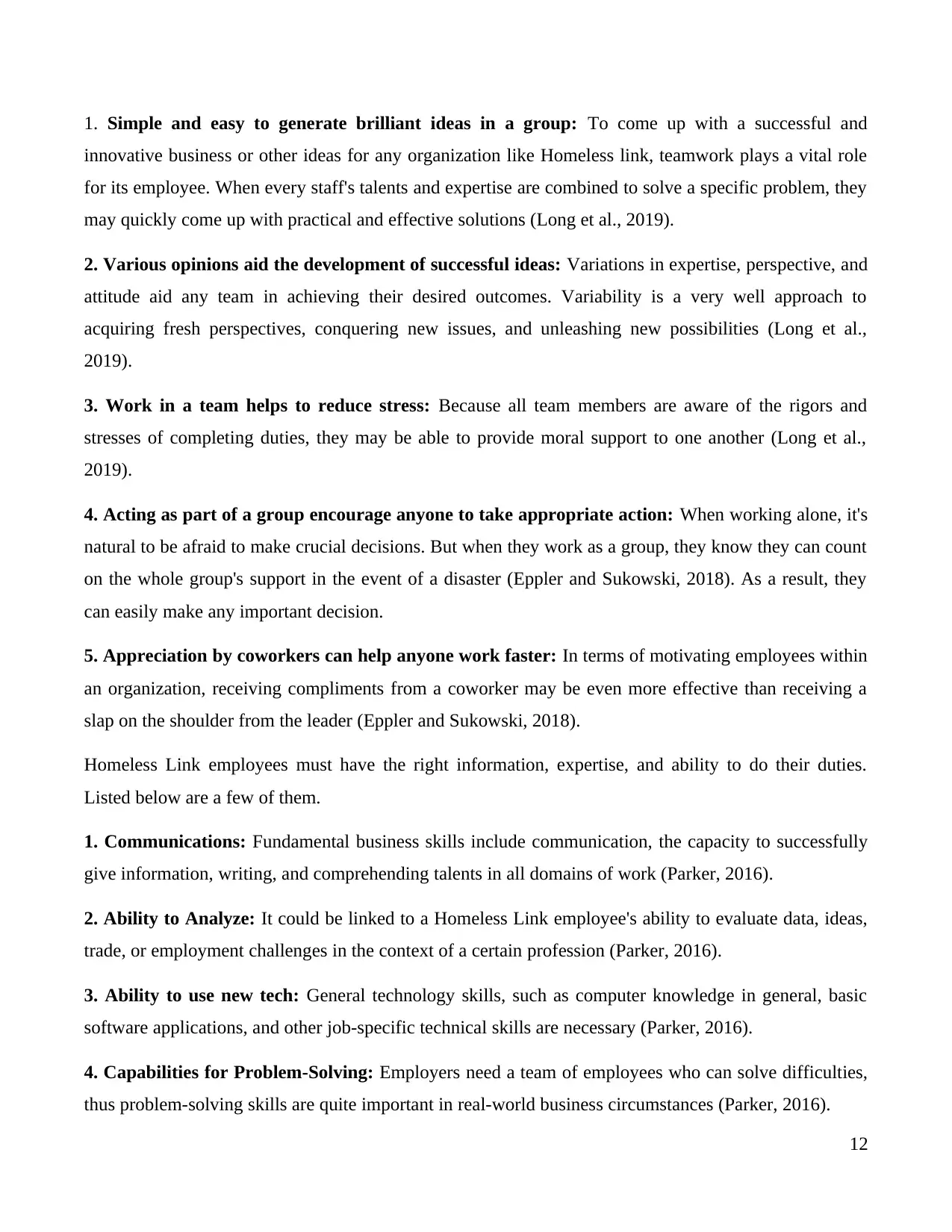
1. Simple and easy to generate brilliant ideas in a group: To come up with a successful and
innovative business or other ideas for any organization like Homeless link, teamwork plays a vital role
for its employee. When every staff's talents and expertise are combined to solve a specific problem, they
may quickly come up with practical and effective solutions (Long et al., 2019).
2. Various opinions aid the development of successful ideas: Variations in expertise, perspective, and
attitude aid any team in achieving their desired outcomes. Variability is a very well approach to
acquiring fresh perspectives, conquering new issues, and unleashing new possibilities (Long et al.,
2019).
3. Work in a team helps to reduce stress: Because all team members are aware of the rigors and
stresses of completing duties, they may be able to provide moral support to one another (Long et al.,
2019).
4. Acting as part of a group encourage anyone to take appropriate action: When working alone, it's
natural to be afraid to make crucial decisions. But when they work as a group, they know they can count
on the whole group's support in the event of a disaster (Eppler and Sukowski, 2018). As a result, they
can easily make any important decision.
5. Appreciation by coworkers can help anyone work faster: In terms of motivating employees within
an organization, receiving compliments from a coworker may be even more effective than receiving a
slap on the shoulder from the leader (Eppler and Sukowski, 2018).
Homeless Link employees must have the right information, expertise, and ability to do their duties.
Listed below are a few of them.
1. Communications: Fundamental business skills include communication, the capacity to successfully
give information, writing, and comprehending talents in all domains of work (Parker, 2016).
2. Ability to Analyze: It could be linked to a Homeless Link employee's ability to evaluate data, ideas,
trade, or employment challenges in the context of a certain profession (Parker, 2016).
3. Ability to use new tech: General technology skills, such as computer knowledge in general, basic
software applications, and other job-specific technical skills are necessary (Parker, 2016).
4. Capabilities for Problem-Solving: Employers need a team of employees who can solve difficulties,
thus problem-solving skills are quite important in real-world business circumstances (Parker, 2016).
12
innovative business or other ideas for any organization like Homeless link, teamwork plays a vital role
for its employee. When every staff's talents and expertise are combined to solve a specific problem, they
may quickly come up with practical and effective solutions (Long et al., 2019).
2. Various opinions aid the development of successful ideas: Variations in expertise, perspective, and
attitude aid any team in achieving their desired outcomes. Variability is a very well approach to
acquiring fresh perspectives, conquering new issues, and unleashing new possibilities (Long et al.,
2019).
3. Work in a team helps to reduce stress: Because all team members are aware of the rigors and
stresses of completing duties, they may be able to provide moral support to one another (Long et al.,
2019).
4. Acting as part of a group encourage anyone to take appropriate action: When working alone, it's
natural to be afraid to make crucial decisions. But when they work as a group, they know they can count
on the whole group's support in the event of a disaster (Eppler and Sukowski, 2018). As a result, they
can easily make any important decision.
5. Appreciation by coworkers can help anyone work faster: In terms of motivating employees within
an organization, receiving compliments from a coworker may be even more effective than receiving a
slap on the shoulder from the leader (Eppler and Sukowski, 2018).
Homeless Link employees must have the right information, expertise, and ability to do their duties.
Listed below are a few of them.
1. Communications: Fundamental business skills include communication, the capacity to successfully
give information, writing, and comprehending talents in all domains of work (Parker, 2016).
2. Ability to Analyze: It could be linked to a Homeless Link employee's ability to evaluate data, ideas,
trade, or employment challenges in the context of a certain profession (Parker, 2016).
3. Ability to use new tech: General technology skills, such as computer knowledge in general, basic
software applications, and other job-specific technical skills are necessary (Parker, 2016).
4. Capabilities for Problem-Solving: Employers need a team of employees who can solve difficulties,
thus problem-solving skills are quite important in real-world business circumstances (Parker, 2016).
12
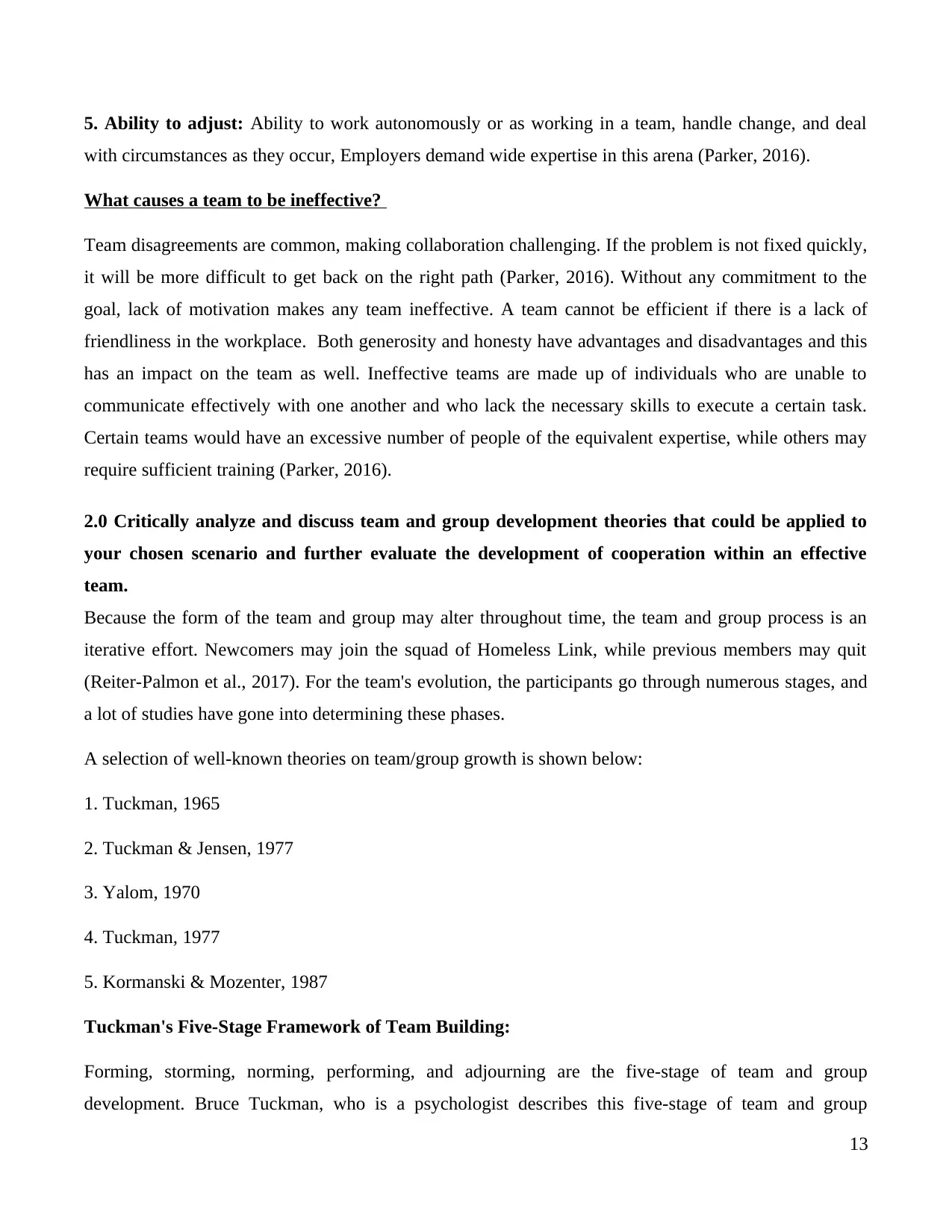
5. Ability to adjust: Ability to work autonomously or as working in a team, handle change, and deal
with circumstances as they occur, Employers demand wide expertise in this arena (Parker, 2016).
What causes a team to be ineffective?
Team disagreements are common, making collaboration challenging. If the problem is not fixed quickly,
it will be more difficult to get back on the right path (Parker, 2016). Without any commitment to the
goal, lack of motivation makes any team ineffective. A team cannot be efficient if there is a lack of
friendliness in the workplace. Both generosity and honesty have advantages and disadvantages and this
has an impact on the team as well. Ineffective teams are made up of individuals who are unable to
communicate effectively with one another and who lack the necessary skills to execute a certain task.
Certain teams would have an excessive number of people of the equivalent expertise, while others may
require sufficient training (Parker, 2016).
2.0 Critically analyze and discuss team and group development theories that could be applied to
your chosen scenario and further evaluate the development of cooperation within an effective
team.
Because the form of the team and group may alter throughout time, the team and group process is an
iterative effort. Newcomers may join the squad of Homeless Link, while previous members may quit
(Reiter-Palmon et al., 2017). For the team's evolution, the participants go through numerous stages, and
a lot of studies have gone into determining these phases.
A selection of well-known theories on team/group growth is shown below:
1. Tuckman, 1965
2. Tuckman & Jensen, 1977
3. Yalom, 1970
4. Tuckman, 1977
5. Kormanski & Mozenter, 1987
Tuckman's Five-Stage Framework of Team Building:
Forming, storming, norming, performing, and adjourning are the five-stage of team and group
development. Bruce Tuckman, who is a psychologist describes this five-stage of team and group
13
with circumstances as they occur, Employers demand wide expertise in this arena (Parker, 2016).
What causes a team to be ineffective?
Team disagreements are common, making collaboration challenging. If the problem is not fixed quickly,
it will be more difficult to get back on the right path (Parker, 2016). Without any commitment to the
goal, lack of motivation makes any team ineffective. A team cannot be efficient if there is a lack of
friendliness in the workplace. Both generosity and honesty have advantages and disadvantages and this
has an impact on the team as well. Ineffective teams are made up of individuals who are unable to
communicate effectively with one another and who lack the necessary skills to execute a certain task.
Certain teams would have an excessive number of people of the equivalent expertise, while others may
require sufficient training (Parker, 2016).
2.0 Critically analyze and discuss team and group development theories that could be applied to
your chosen scenario and further evaluate the development of cooperation within an effective
team.
Because the form of the team and group may alter throughout time, the team and group process is an
iterative effort. Newcomers may join the squad of Homeless Link, while previous members may quit
(Reiter-Palmon et al., 2017). For the team's evolution, the participants go through numerous stages, and
a lot of studies have gone into determining these phases.
A selection of well-known theories on team/group growth is shown below:
1. Tuckman, 1965
2. Tuckman & Jensen, 1977
3. Yalom, 1970
4. Tuckman, 1977
5. Kormanski & Mozenter, 1987
Tuckman's Five-Stage Framework of Team Building:
Forming, storming, norming, performing, and adjourning are the five-stage of team and group
development. Bruce Tuckman, who is a psychologist describes this five-stage of team and group
13
Paraphrase This Document
Need a fresh take? Get an instant paraphrase of this document with our AI Paraphraser
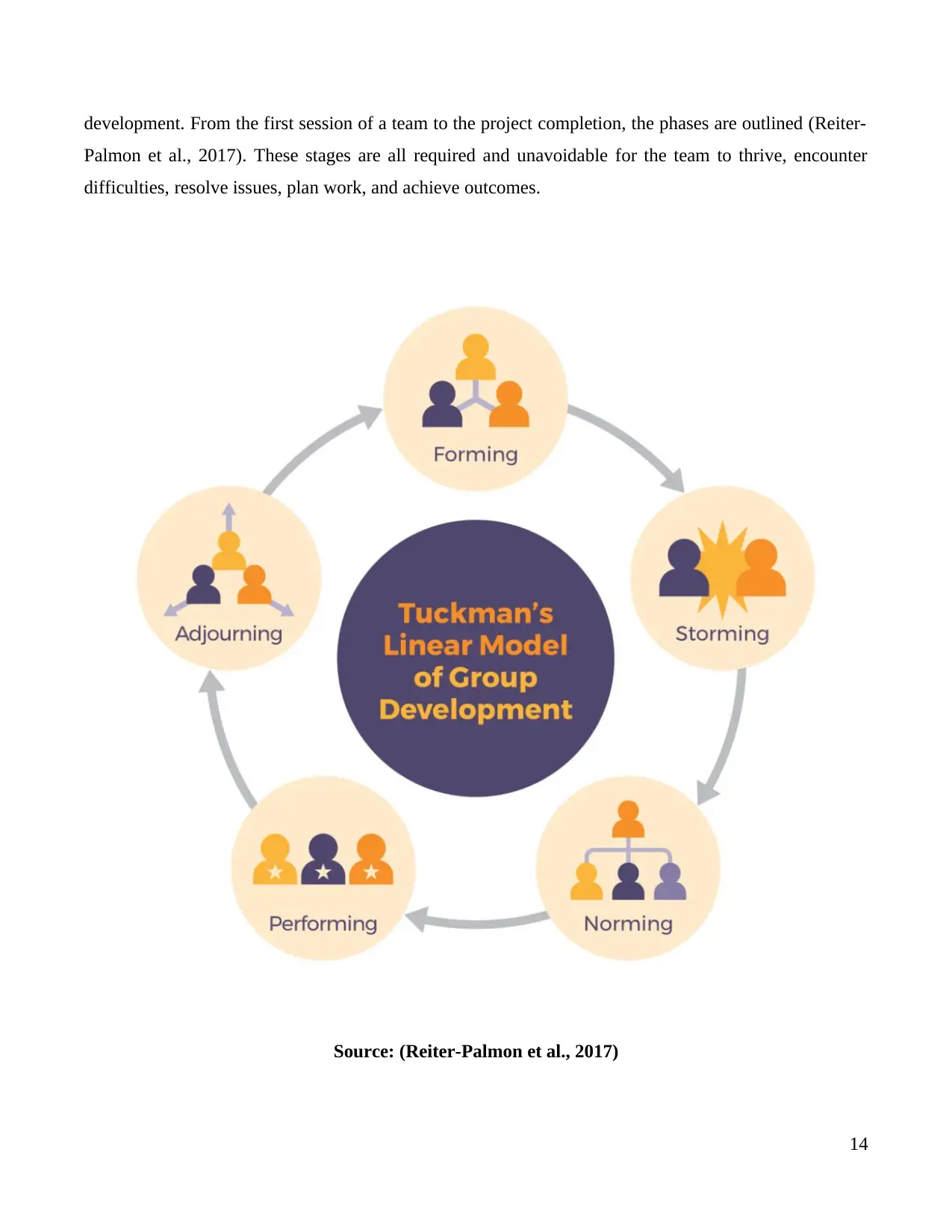
development. From the first session of a team to the project completion, the phases are outlined (Reiter-
Palmon et al., 2017). These stages are all required and unavoidable for the team to thrive, encounter
difficulties, resolve issues, plan work, and achieve outcomes.
Source: (Reiter-Palmon et al., 2017)
14
Palmon et al., 2017). These stages are all required and unavoidable for the team to thrive, encounter
difficulties, resolve issues, plan work, and achieve outcomes.
Source: (Reiter-Palmon et al., 2017)
14
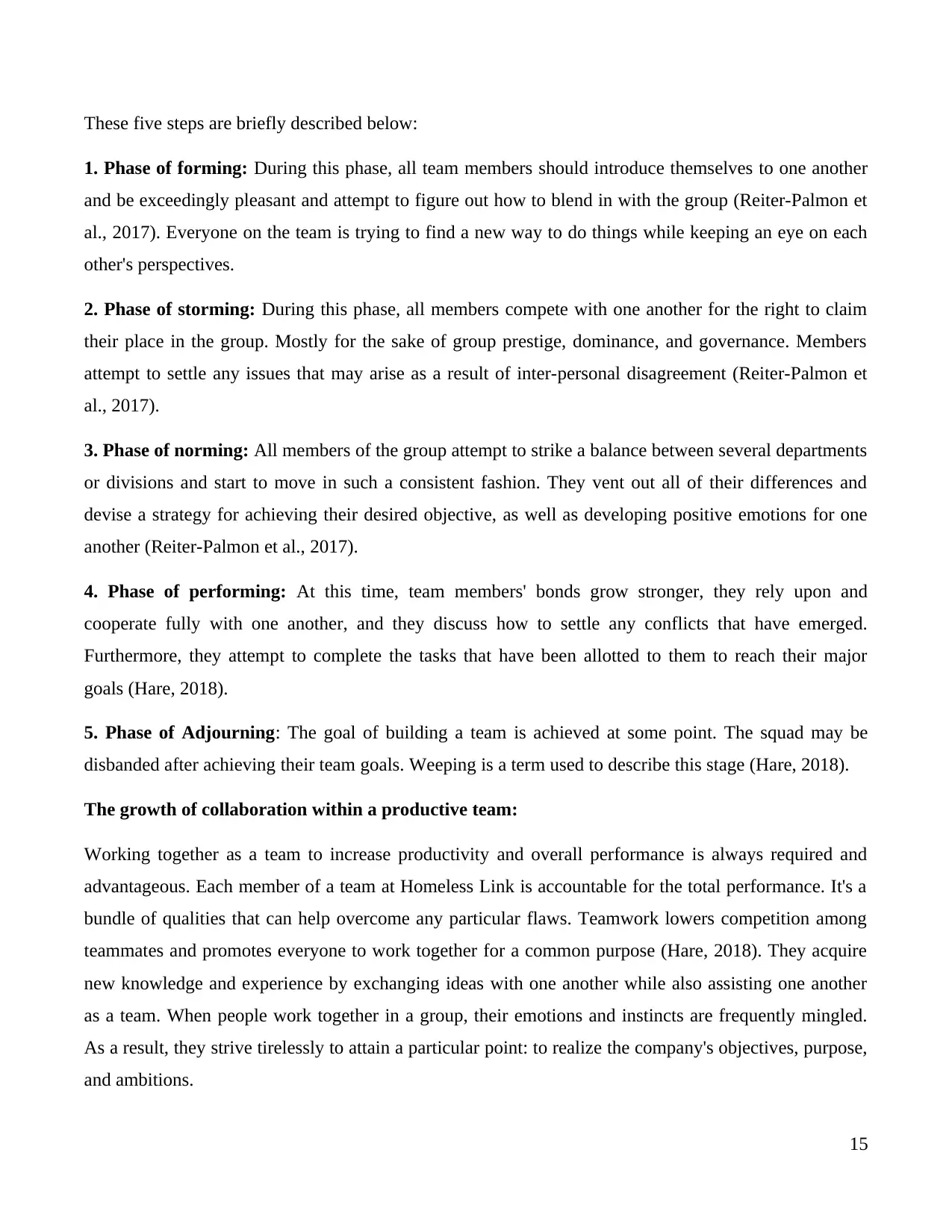
These five steps are briefly described below:
1. Phase of forming: During this phase, all team members should introduce themselves to one another
and be exceedingly pleasant and attempt to figure out how to blend in with the group (Reiter-Palmon et
al., 2017). Everyone on the team is trying to find a new way to do things while keeping an eye on each
other's perspectives.
2. Phase of storming: During this phase, all members compete with one another for the right to claim
their place in the group. Mostly for the sake of group prestige, dominance, and governance. Members
attempt to settle any issues that may arise as a result of inter-personal disagreement (Reiter-Palmon et
al., 2017).
3. Phase of norming: All members of the group attempt to strike a balance between several departments
or divisions and start to move in such a consistent fashion. They vent out all of their differences and
devise a strategy for achieving their desired objective, as well as developing positive emotions for one
another (Reiter-Palmon et al., 2017).
4. Phase of performing: At this time, team members' bonds grow stronger, they rely upon and
cooperate fully with one another, and they discuss how to settle any conflicts that have emerged.
Furthermore, they attempt to complete the tasks that have been allotted to them to reach their major
goals (Hare, 2018).
5. Phase of Adjourning: The goal of building a team is achieved at some point. The squad may be
disbanded after achieving their team goals. Weeping is a term used to describe this stage (Hare, 2018).
The growth of collaboration within a productive team:
Working together as a team to increase productivity and overall performance is always required and
advantageous. Each member of a team at Homeless Link is accountable for the total performance. It's a
bundle of qualities that can help overcome any particular flaws. Teamwork lowers competition among
teammates and promotes everyone to work together for a common purpose (Hare, 2018). They acquire
new knowledge and experience by exchanging ideas with one another while also assisting one another
as a team. When people work together in a group, their emotions and instincts are frequently mingled.
As a result, they strive tirelessly to attain a particular point: to realize the company's objectives, purpose,
and ambitions.
15
1. Phase of forming: During this phase, all team members should introduce themselves to one another
and be exceedingly pleasant and attempt to figure out how to blend in with the group (Reiter-Palmon et
al., 2017). Everyone on the team is trying to find a new way to do things while keeping an eye on each
other's perspectives.
2. Phase of storming: During this phase, all members compete with one another for the right to claim
their place in the group. Mostly for the sake of group prestige, dominance, and governance. Members
attempt to settle any issues that may arise as a result of inter-personal disagreement (Reiter-Palmon et
al., 2017).
3. Phase of norming: All members of the group attempt to strike a balance between several departments
or divisions and start to move in such a consistent fashion. They vent out all of their differences and
devise a strategy for achieving their desired objective, as well as developing positive emotions for one
another (Reiter-Palmon et al., 2017).
4. Phase of performing: At this time, team members' bonds grow stronger, they rely upon and
cooperate fully with one another, and they discuss how to settle any conflicts that have emerged.
Furthermore, they attempt to complete the tasks that have been allotted to them to reach their major
goals (Hare, 2018).
5. Phase of Adjourning: The goal of building a team is achieved at some point. The squad may be
disbanded after achieving their team goals. Weeping is a term used to describe this stage (Hare, 2018).
The growth of collaboration within a productive team:
Working together as a team to increase productivity and overall performance is always required and
advantageous. Each member of a team at Homeless Link is accountable for the total performance. It's a
bundle of qualities that can help overcome any particular flaws. Teamwork lowers competition among
teammates and promotes everyone to work together for a common purpose (Hare, 2018). They acquire
new knowledge and experience by exchanging ideas with one another while also assisting one another
as a team. When people work together in a group, their emotions and instincts are frequently mingled.
As a result, they strive tirelessly to attain a particular point: to realize the company's objectives, purpose,
and ambitions.
15
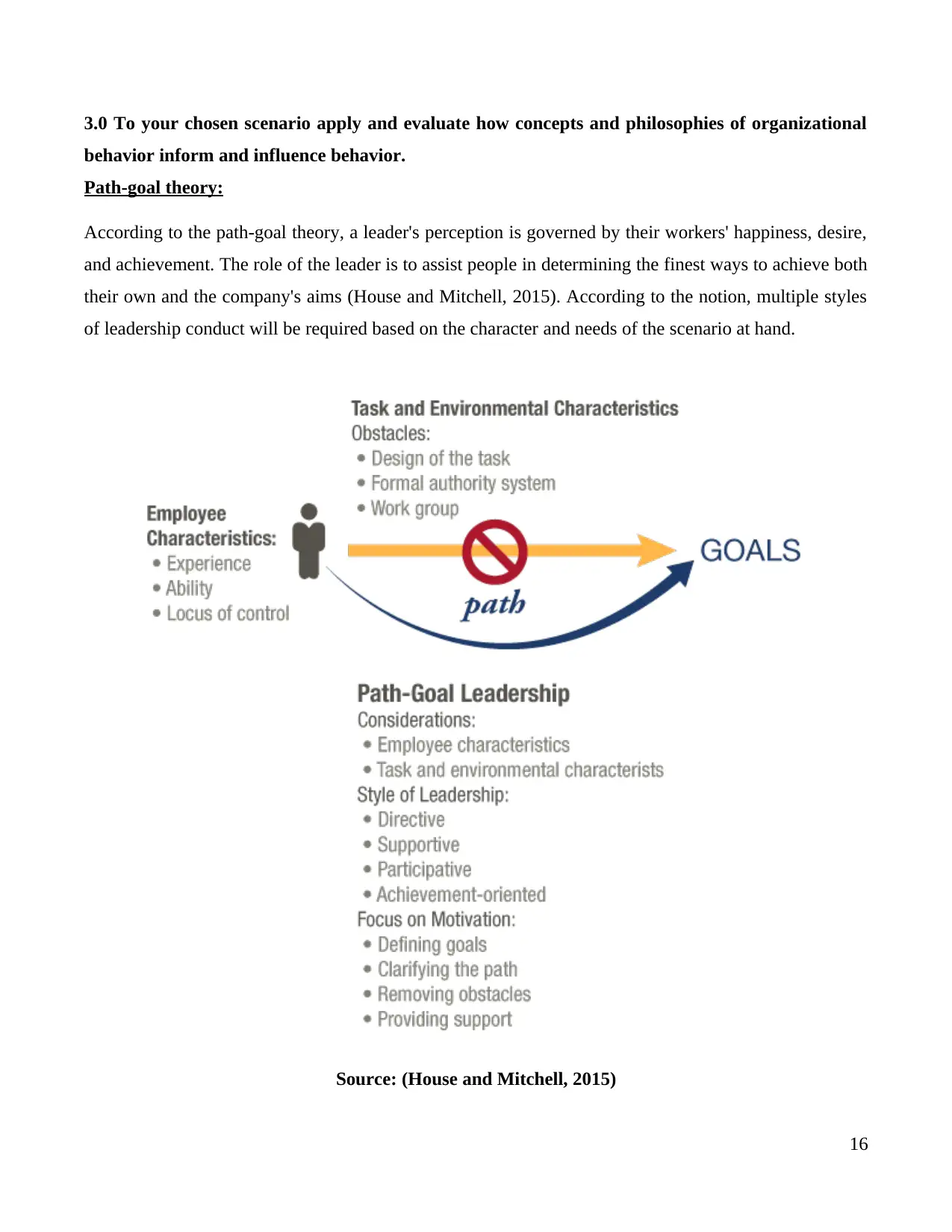
3.0 To your chosen scenario apply and evaluate how concepts and philosophies of organizational
behavior inform and influence behavior.
Path-goal theory:
According to the path-goal theory, a leader's perception is governed by their workers' happiness, desire,
and achievement. The role of the leader is to assist people in determining the finest ways to achieve both
their own and the company's aims (House and Mitchell, 2015). According to the notion, multiple styles
of leadership conduct will be required based on the character and needs of the scenario at hand.
Source: (House and Mitchell, 2015)
16
behavior inform and influence behavior.
Path-goal theory:
According to the path-goal theory, a leader's perception is governed by their workers' happiness, desire,
and achievement. The role of the leader is to assist people in determining the finest ways to achieve both
their own and the company's aims (House and Mitchell, 2015). According to the notion, multiple styles
of leadership conduct will be required based on the character and needs of the scenario at hand.
Source: (House and Mitchell, 2015)
16
Secure Best Marks with AI Grader
Need help grading? Try our AI Grader for instant feedback on your assignments.
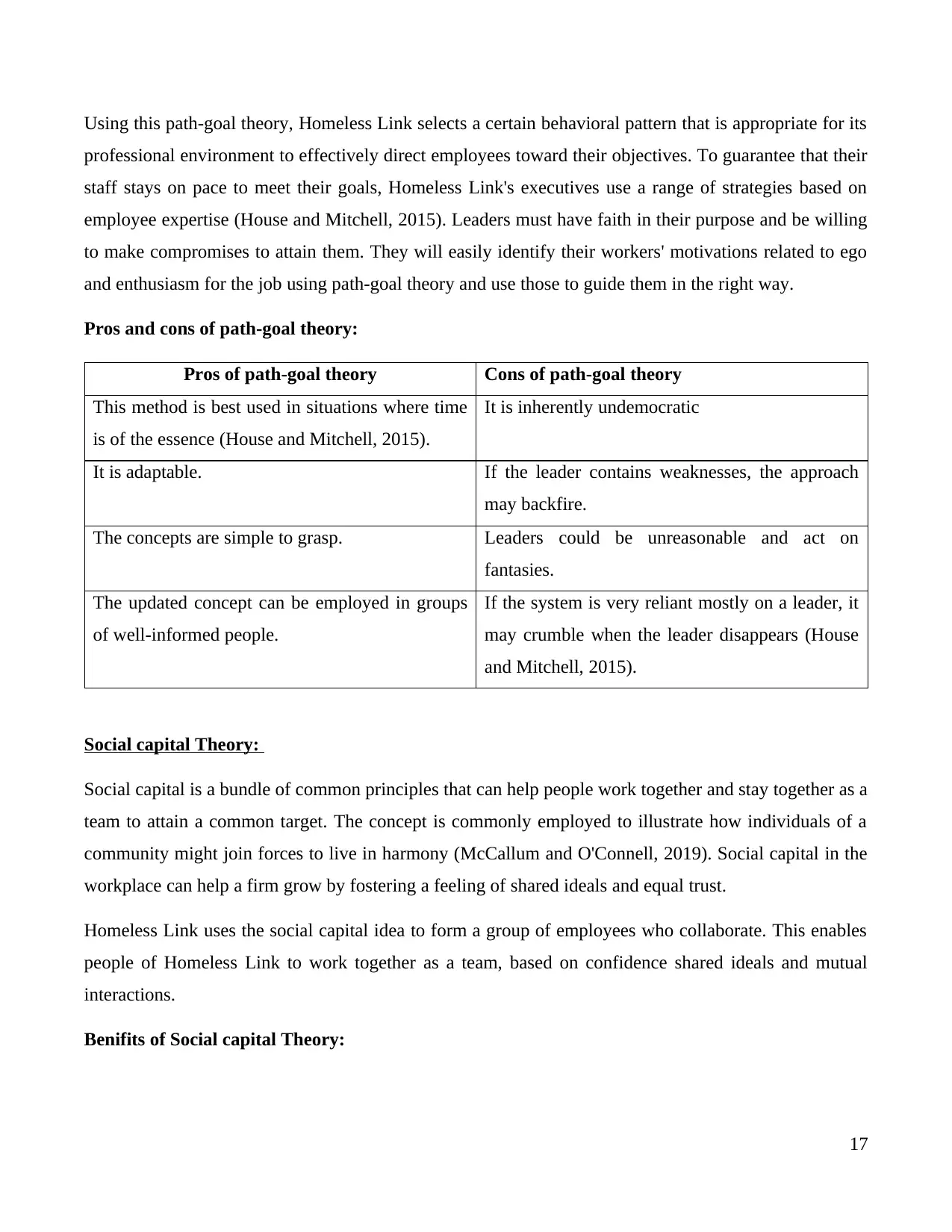
Using this path-goal theory, Homeless Link selects a certain behavioral pattern that is appropriate for its
professional environment to effectively direct employees toward their objectives. To guarantee that their
staff stays on pace to meet their goals, Homeless Link's executives use a range of strategies based on
employee expertise (House and Mitchell, 2015). Leaders must have faith in their purpose and be willing
to make compromises to attain them. They will easily identify their workers' motivations related to ego
and enthusiasm for the job using path-goal theory and use those to guide them in the right way.
Pros and cons of path-goal theory:
Pros of path-goal theory Cons of path-goal theory
This method is best used in situations where time
is of the essence (House and Mitchell, 2015).
It is inherently undemocratic
It is adaptable. If the leader contains weaknesses, the approach
may backfire.
The concepts are simple to grasp. Leaders could be unreasonable and act on
fantasies.
The updated concept can be employed in groups
of well-informed people.
If the system is very reliant mostly on a leader, it
may crumble when the leader disappears (House
and Mitchell, 2015).
Social capital Theory:
Social capital is a bundle of common principles that can help people work together and stay together as a
team to attain a common target. The concept is commonly employed to illustrate how individuals of a
community might join forces to live in harmony (McCallum and O'Connell, 2019). Social capital in the
workplace can help a firm grow by fostering a feeling of shared ideals and equal trust.
Homeless Link uses the social capital idea to form a group of employees who collaborate. This enables
people of Homeless Link to work together as a team, based on confidence shared ideals and mutual
interactions.
Benifits of Social capital Theory:
17
professional environment to effectively direct employees toward their objectives. To guarantee that their
staff stays on pace to meet their goals, Homeless Link's executives use a range of strategies based on
employee expertise (House and Mitchell, 2015). Leaders must have faith in their purpose and be willing
to make compromises to attain them. They will easily identify their workers' motivations related to ego
and enthusiasm for the job using path-goal theory and use those to guide them in the right way.
Pros and cons of path-goal theory:
Pros of path-goal theory Cons of path-goal theory
This method is best used in situations where time
is of the essence (House and Mitchell, 2015).
It is inherently undemocratic
It is adaptable. If the leader contains weaknesses, the approach
may backfire.
The concepts are simple to grasp. Leaders could be unreasonable and act on
fantasies.
The updated concept can be employed in groups
of well-informed people.
If the system is very reliant mostly on a leader, it
may crumble when the leader disappears (House
and Mitchell, 2015).
Social capital Theory:
Social capital is a bundle of common principles that can help people work together and stay together as a
team to attain a common target. The concept is commonly employed to illustrate how individuals of a
community might join forces to live in harmony (McCallum and O'Connell, 2019). Social capital in the
workplace can help a firm grow by fostering a feeling of shared ideals and equal trust.
Homeless Link uses the social capital idea to form a group of employees who collaborate. This enables
people of Homeless Link to work together as a team, based on confidence shared ideals and mutual
interactions.
Benifits of Social capital Theory:
17
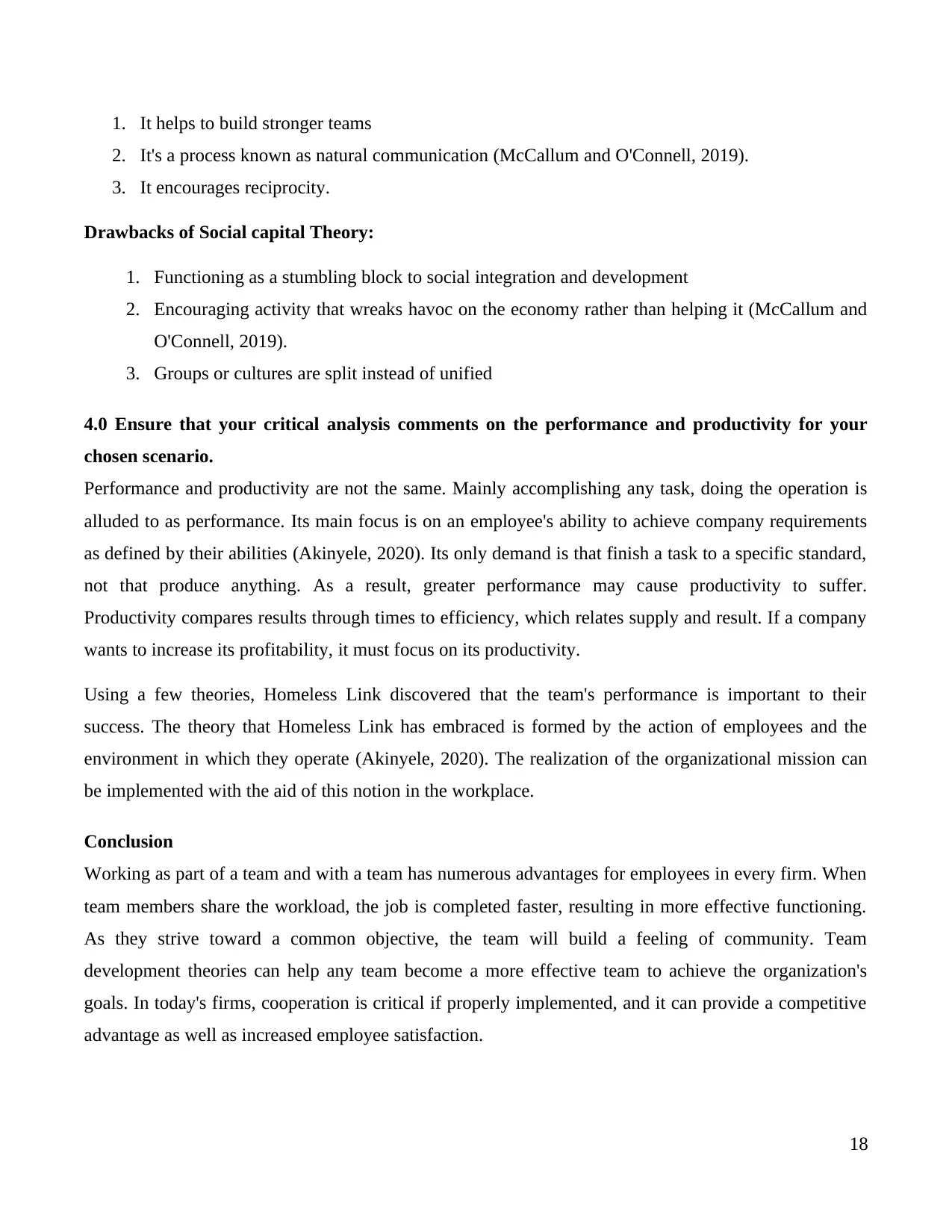
1. It helps to build stronger teams
2. It's a process known as natural communication (McCallum and O'Connell, 2019).
3. It encourages reciprocity.
Drawbacks of Social capital Theory:
1. Functioning as a stumbling block to social integration and development
2. Encouraging activity that wreaks havoc on the economy rather than helping it (McCallum and
O'Connell, 2019).
3. Groups or cultures are split instead of unified
4.0 Ensure that your critical analysis comments on the performance and productivity for your
chosen scenario.
Performance and productivity are not the same. Mainly accomplishing any task, doing the operation is
alluded to as performance. Its main focus is on an employee's ability to achieve company requirements
as defined by their abilities (Akinyele, 2020). Its only demand is that finish a task to a specific standard,
not that produce anything. As a result, greater performance may cause productivity to suffer.
Productivity compares results through times to efficiency, which relates supply and result. If a company
wants to increase its profitability, it must focus on its productivity.
Using a few theories, Homeless Link discovered that the team's performance is important to their
success. The theory that Homeless Link has embraced is formed by the action of employees and the
environment in which they operate (Akinyele, 2020). The realization of the organizational mission can
be implemented with the aid of this notion in the workplace.
Conclusion
Working as part of a team and with a team has numerous advantages for employees in every firm. When
team members share the workload, the job is completed faster, resulting in more effective functioning.
As they strive toward a common objective, the team will build a feeling of community. Team
development theories can help any team become a more effective team to achieve the organization's
goals. In today's firms, cooperation is critical if properly implemented, and it can provide a competitive
advantage as well as increased employee satisfaction.
18
2. It's a process known as natural communication (McCallum and O'Connell, 2019).
3. It encourages reciprocity.
Drawbacks of Social capital Theory:
1. Functioning as a stumbling block to social integration and development
2. Encouraging activity that wreaks havoc on the economy rather than helping it (McCallum and
O'Connell, 2019).
3. Groups or cultures are split instead of unified
4.0 Ensure that your critical analysis comments on the performance and productivity for your
chosen scenario.
Performance and productivity are not the same. Mainly accomplishing any task, doing the operation is
alluded to as performance. Its main focus is on an employee's ability to achieve company requirements
as defined by their abilities (Akinyele, 2020). Its only demand is that finish a task to a specific standard,
not that produce anything. As a result, greater performance may cause productivity to suffer.
Productivity compares results through times to efficiency, which relates supply and result. If a company
wants to increase its profitability, it must focus on its productivity.
Using a few theories, Homeless Link discovered that the team's performance is important to their
success. The theory that Homeless Link has embraced is formed by the action of employees and the
environment in which they operate (Akinyele, 2020). The realization of the organizational mission can
be implemented with the aid of this notion in the workplace.
Conclusion
Working as part of a team and with a team has numerous advantages for employees in every firm. When
team members share the workload, the job is completed faster, resulting in more effective functioning.
As they strive toward a common objective, the team will build a feeling of community. Team
development theories can help any team become a more effective team to achieve the organization's
goals. In today's firms, cooperation is critical if properly implemented, and it can provide a competitive
advantage as well as increased employee satisfaction.
18
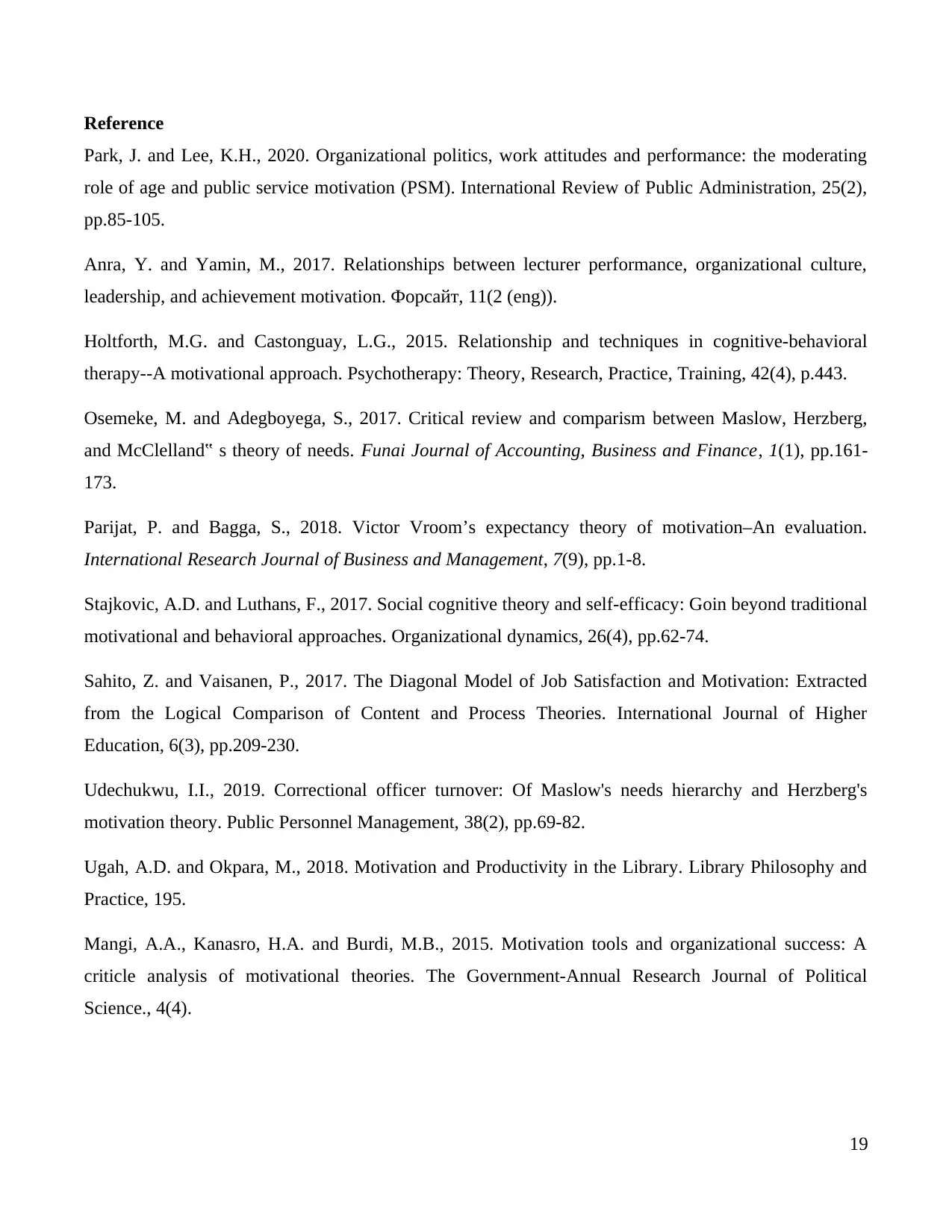
Reference
Park, J. and Lee, K.H., 2020. Organizational politics, work attitudes and performance: the moderating
role of age and public service motivation (PSM). International Review of Public Administration, 25(2),
pp.85-105.
Anra, Y. and Yamin, M., 2017. Relationships between lecturer performance, organizational culture,
leadership, and achievement motivation. Форсайт, 11(2 (eng)).
Holtforth, M.G. and Castonguay, L.G., 2015. Relationship and techniques in cognitive-behavioral
therapy--A motivational approach. Psychotherapy: Theory, Research, Practice, Training, 42(4), p.443.
Osemeke, M. and Adegboyega, S., 2017. Critical review and comparism between Maslow, Herzberg,
and McClelland‟ s theory of needs. Funai Journal of Accounting, Business and Finance, 1(1), pp.161-
173.
Parijat, P. and Bagga, S., 2018. Victor Vroom’s expectancy theory of motivation–An evaluation.
International Research Journal of Business and Management, 7(9), pp.1-8.
Stajkovic, A.D. and Luthans, F., 2017. Social cognitive theory and self-efficacy: Goin beyond traditional
motivational and behavioral approaches. Organizational dynamics, 26(4), pp.62-74.
Sahito, Z. and Vaisanen, P., 2017. The Diagonal Model of Job Satisfaction and Motivation: Extracted
from the Logical Comparison of Content and Process Theories. International Journal of Higher
Education, 6(3), pp.209-230.
Udechukwu, I.I., 2019. Correctional officer turnover: Of Maslow's needs hierarchy and Herzberg's
motivation theory. Public Personnel Management, 38(2), pp.69-82.
Ugah, A.D. and Okpara, M., 2018. Motivation and Productivity in the Library. Library Philosophy and
Practice, 195.
Mangi, A.A., Kanasro, H.A. and Burdi, M.B., 2015. Motivation tools and organizational success: A
criticle analysis of motivational theories. The Government-Annual Research Journal of Political
Science., 4(4).
19
Park, J. and Lee, K.H., 2020. Organizational politics, work attitudes and performance: the moderating
role of age and public service motivation (PSM). International Review of Public Administration, 25(2),
pp.85-105.
Anra, Y. and Yamin, M., 2017. Relationships between lecturer performance, organizational culture,
leadership, and achievement motivation. Форсайт, 11(2 (eng)).
Holtforth, M.G. and Castonguay, L.G., 2015. Relationship and techniques in cognitive-behavioral
therapy--A motivational approach. Psychotherapy: Theory, Research, Practice, Training, 42(4), p.443.
Osemeke, M. and Adegboyega, S., 2017. Critical review and comparism between Maslow, Herzberg,
and McClelland‟ s theory of needs. Funai Journal of Accounting, Business and Finance, 1(1), pp.161-
173.
Parijat, P. and Bagga, S., 2018. Victor Vroom’s expectancy theory of motivation–An evaluation.
International Research Journal of Business and Management, 7(9), pp.1-8.
Stajkovic, A.D. and Luthans, F., 2017. Social cognitive theory and self-efficacy: Goin beyond traditional
motivational and behavioral approaches. Organizational dynamics, 26(4), pp.62-74.
Sahito, Z. and Vaisanen, P., 2017. The Diagonal Model of Job Satisfaction and Motivation: Extracted
from the Logical Comparison of Content and Process Theories. International Journal of Higher
Education, 6(3), pp.209-230.
Udechukwu, I.I., 2019. Correctional officer turnover: Of Maslow's needs hierarchy and Herzberg's
motivation theory. Public Personnel Management, 38(2), pp.69-82.
Ugah, A.D. and Okpara, M., 2018. Motivation and Productivity in the Library. Library Philosophy and
Practice, 195.
Mangi, A.A., Kanasro, H.A. and Burdi, M.B., 2015. Motivation tools and organizational success: A
criticle analysis of motivational theories. The Government-Annual Research Journal of Political
Science., 4(4).
19
Paraphrase This Document
Need a fresh take? Get an instant paraphrase of this document with our AI Paraphraser
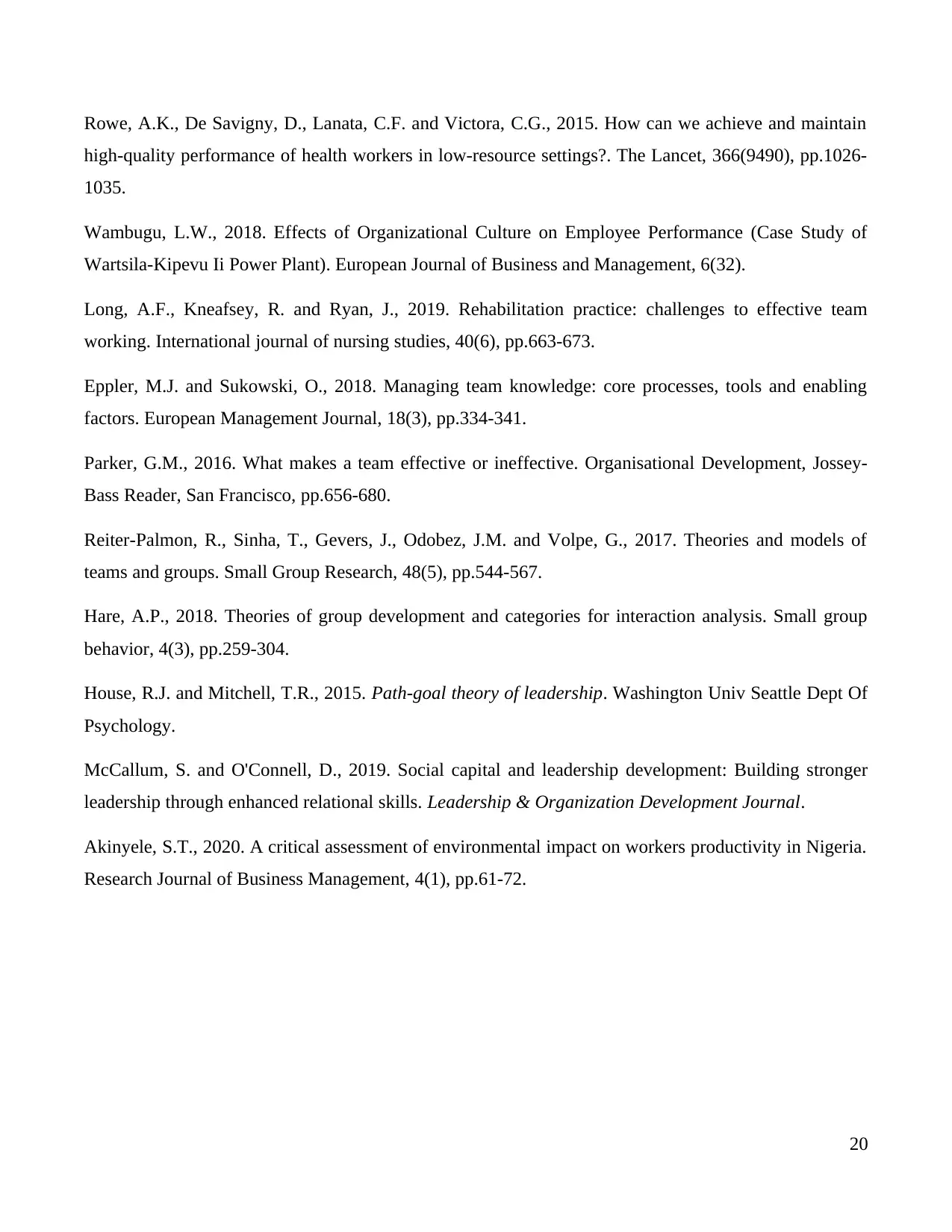
Rowe, A.K., De Savigny, D., Lanata, C.F. and Victora, C.G., 2015. How can we achieve and maintain
high-quality performance of health workers in low-resource settings?. The Lancet, 366(9490), pp.1026-
1035.
Wambugu, L.W., 2018. Effects of Organizational Culture on Employee Performance (Case Study of
Wartsila-Kipevu Ii Power Plant). European Journal of Business and Management, 6(32).
Long, A.F., Kneafsey, R. and Ryan, J., 2019. Rehabilitation practice: challenges to effective team
working. International journal of nursing studies, 40(6), pp.663-673.
Eppler, M.J. and Sukowski, O., 2018. Managing team knowledge: core processes, tools and enabling
factors. European Management Journal, 18(3), pp.334-341.
Parker, G.M., 2016. What makes a team effective or ineffective. Organisational Development, Jossey-
Bass Reader, San Francisco, pp.656-680.
Reiter-Palmon, R., Sinha, T., Gevers, J., Odobez, J.M. and Volpe, G., 2017. Theories and models of
teams and groups. Small Group Research, 48(5), pp.544-567.
Hare, A.P., 2018. Theories of group development and categories for interaction analysis. Small group
behavior, 4(3), pp.259-304.
House, R.J. and Mitchell, T.R., 2015. Path-goal theory of leadership. Washington Univ Seattle Dept Of
Psychology.
McCallum, S. and O'Connell, D., 2019. Social capital and leadership development: Building stronger
leadership through enhanced relational skills. Leadership & Organization Development Journal.
Akinyele, S.T., 2020. A critical assessment of environmental impact on workers productivity in Nigeria.
Research Journal of Business Management, 4(1), pp.61-72.
20
high-quality performance of health workers in low-resource settings?. The Lancet, 366(9490), pp.1026-
1035.
Wambugu, L.W., 2018. Effects of Organizational Culture on Employee Performance (Case Study of
Wartsila-Kipevu Ii Power Plant). European Journal of Business and Management, 6(32).
Long, A.F., Kneafsey, R. and Ryan, J., 2019. Rehabilitation practice: challenges to effective team
working. International journal of nursing studies, 40(6), pp.663-673.
Eppler, M.J. and Sukowski, O., 2018. Managing team knowledge: core processes, tools and enabling
factors. European Management Journal, 18(3), pp.334-341.
Parker, G.M., 2016. What makes a team effective or ineffective. Organisational Development, Jossey-
Bass Reader, San Francisco, pp.656-680.
Reiter-Palmon, R., Sinha, T., Gevers, J., Odobez, J.M. and Volpe, G., 2017. Theories and models of
teams and groups. Small Group Research, 48(5), pp.544-567.
Hare, A.P., 2018. Theories of group development and categories for interaction analysis. Small group
behavior, 4(3), pp.259-304.
House, R.J. and Mitchell, T.R., 2015. Path-goal theory of leadership. Washington Univ Seattle Dept Of
Psychology.
McCallum, S. and O'Connell, D., 2019. Social capital and leadership development: Building stronger
leadership through enhanced relational skills. Leadership & Organization Development Journal.
Akinyele, S.T., 2020. A critical assessment of environmental impact on workers productivity in Nigeria.
Research Journal of Business Management, 4(1), pp.61-72.
20
1 out of 20
Related Documents
Your All-in-One AI-Powered Toolkit for Academic Success.
+13062052269
info@desklib.com
Available 24*7 on WhatsApp / Email
![[object Object]](/_next/static/media/star-bottom.7253800d.svg)
Unlock your academic potential
© 2024 | Zucol Services PVT LTD | All rights reserved.





